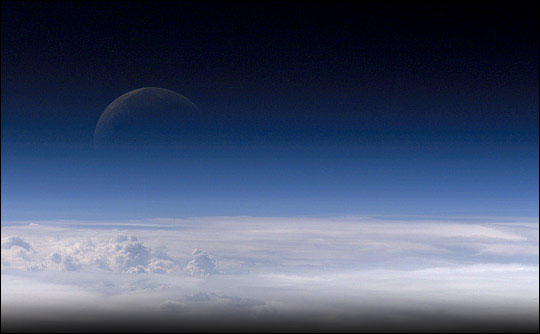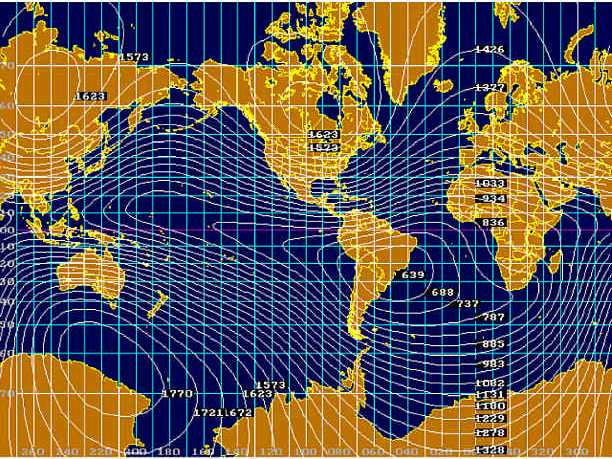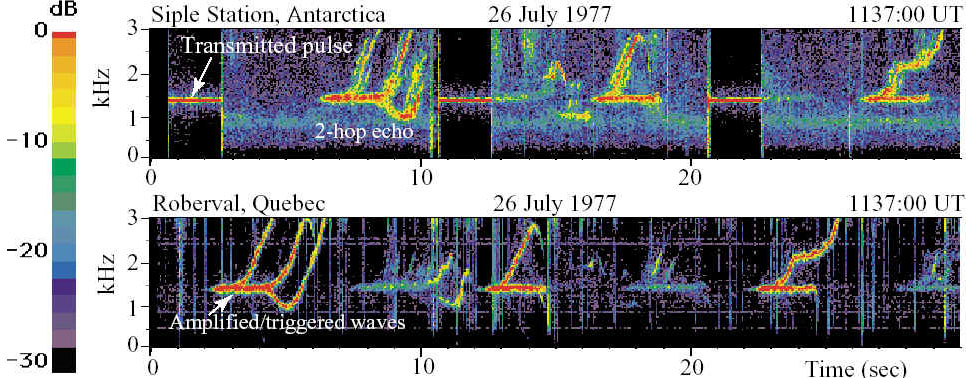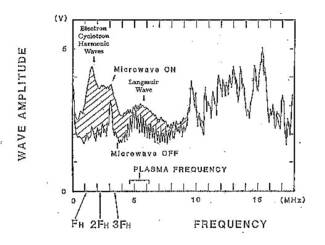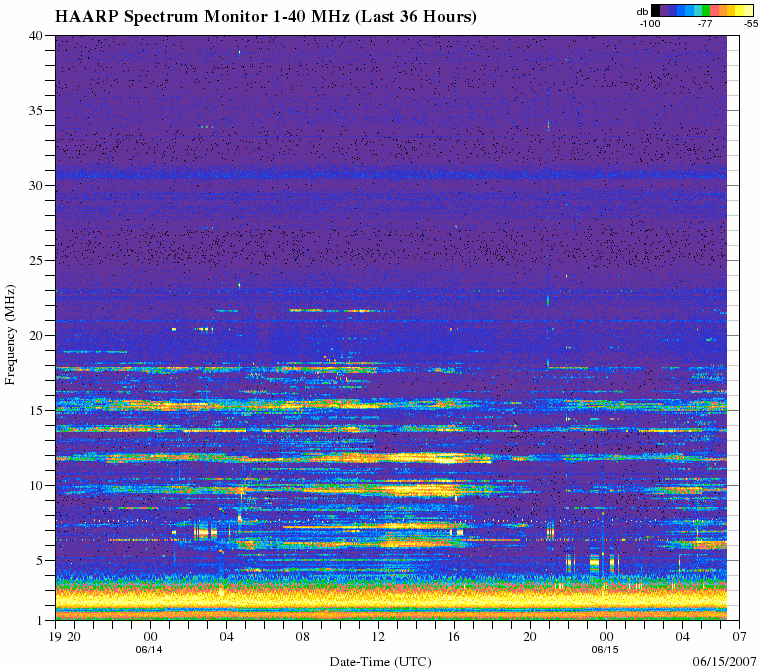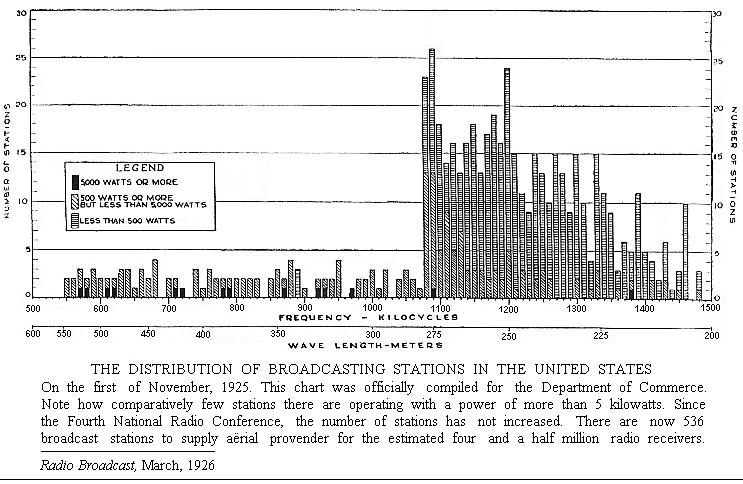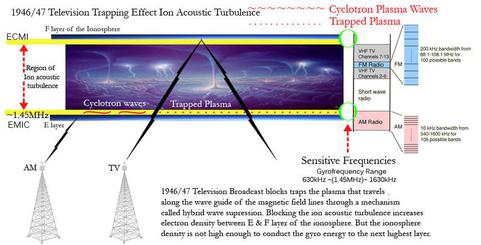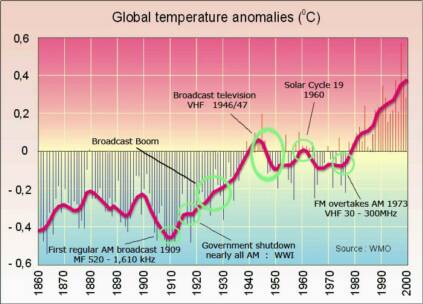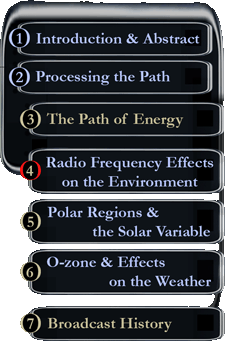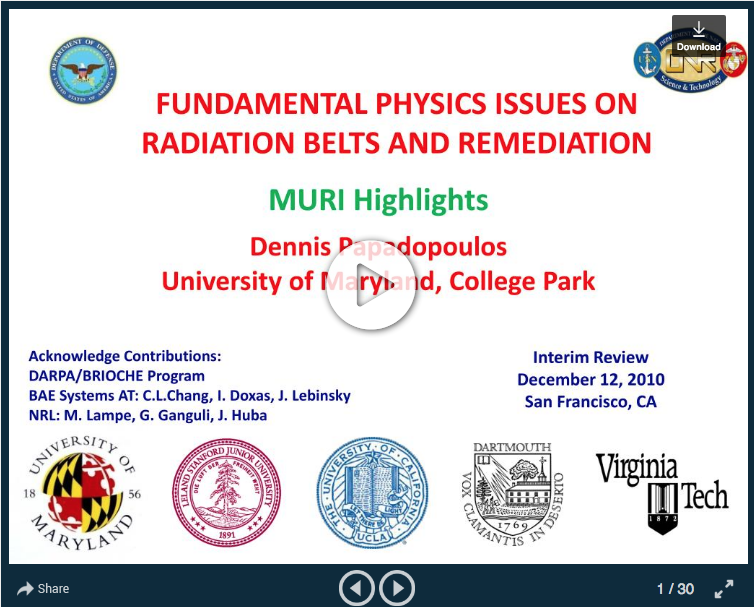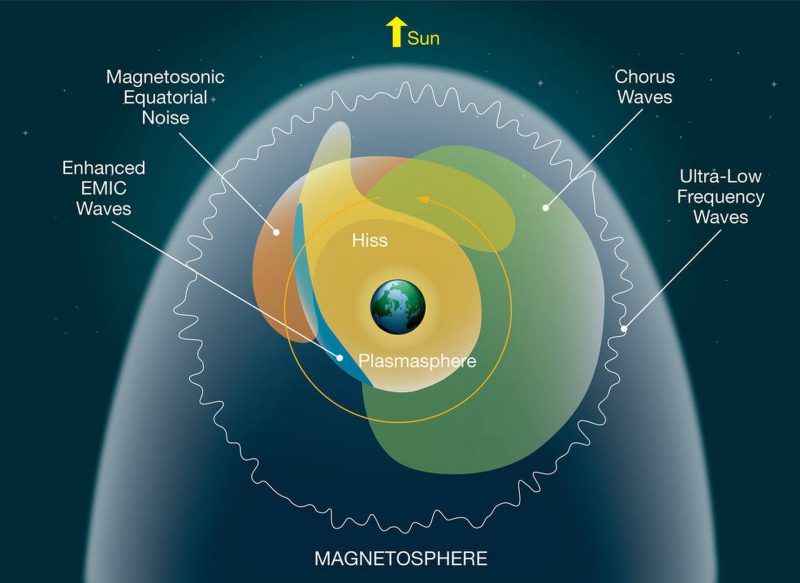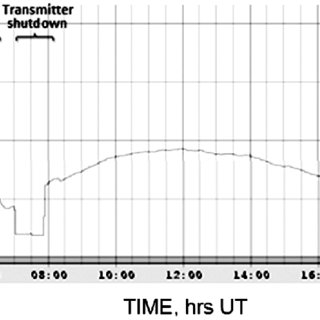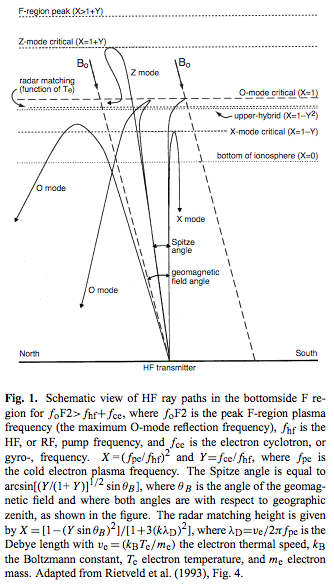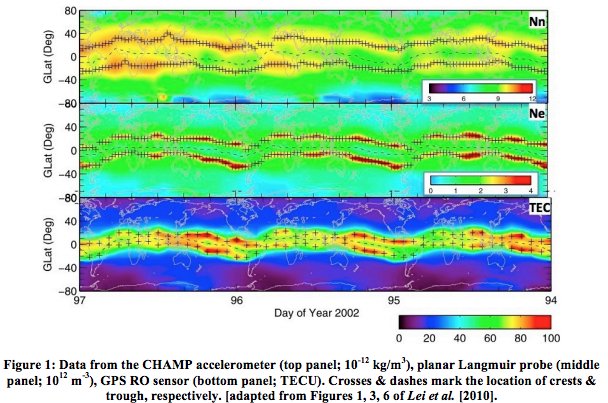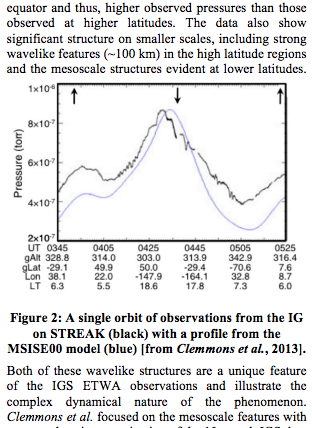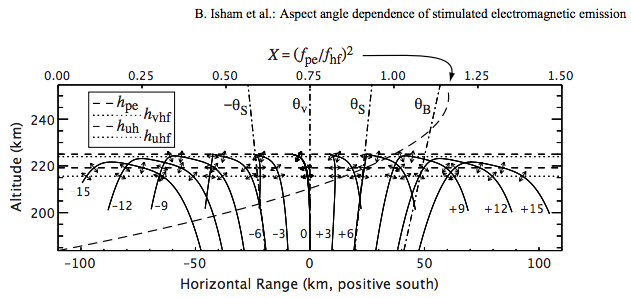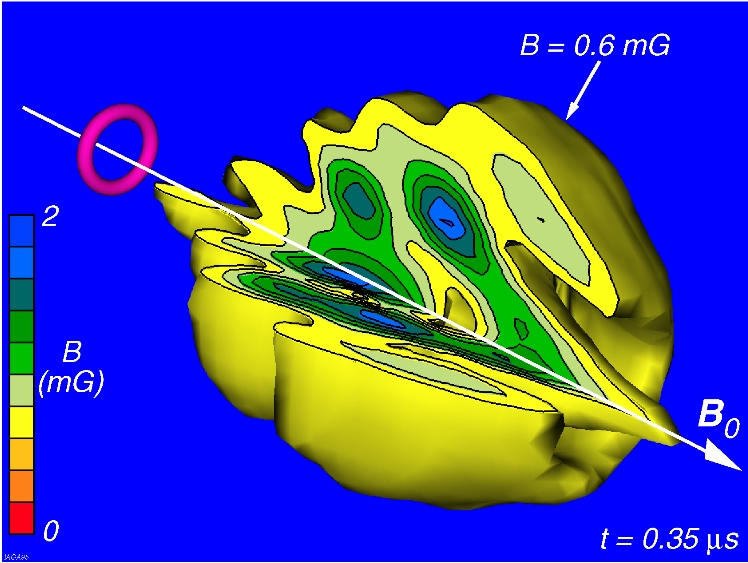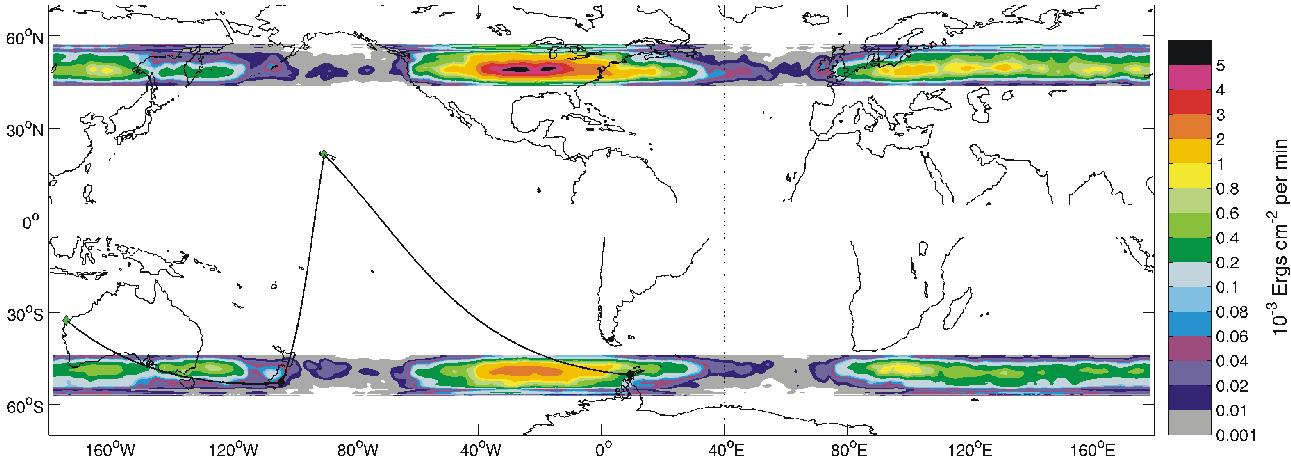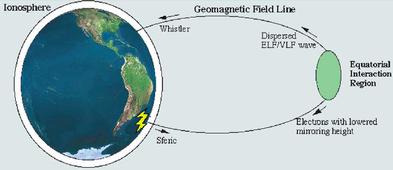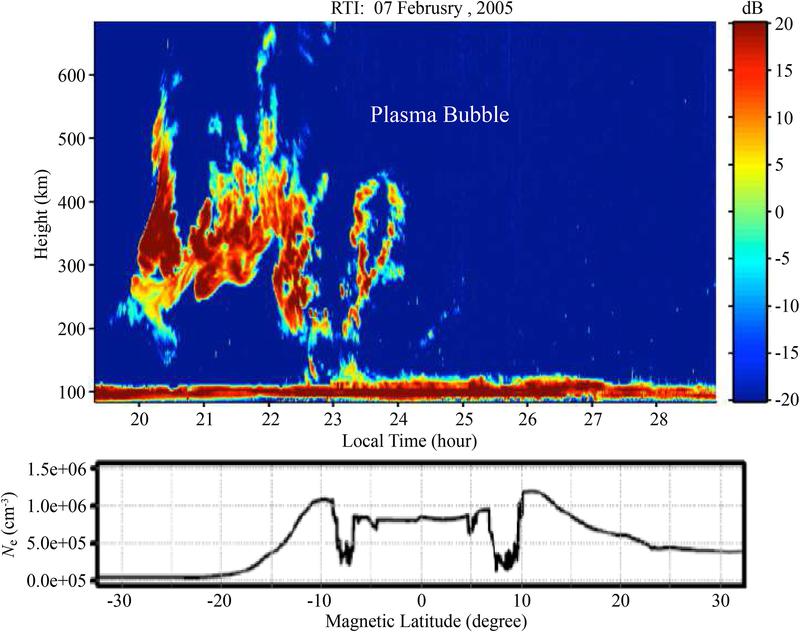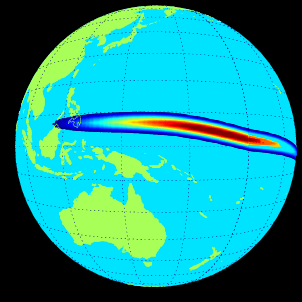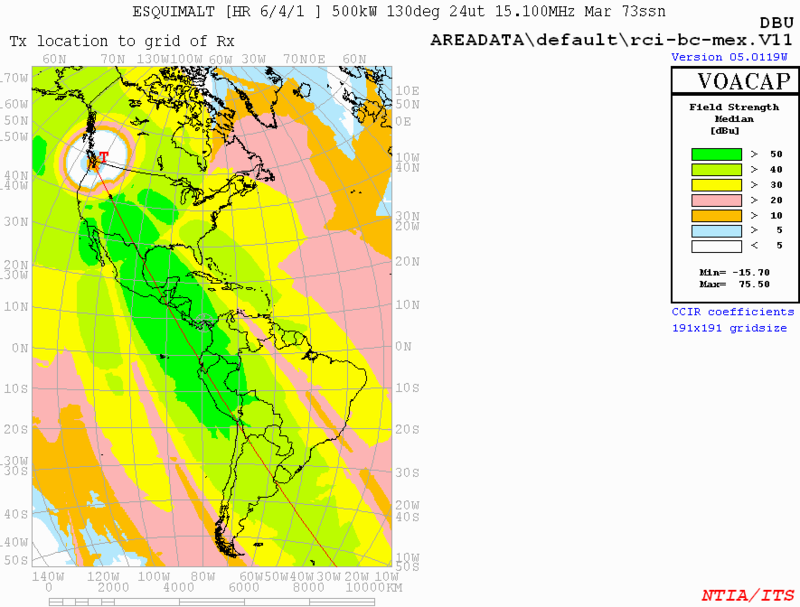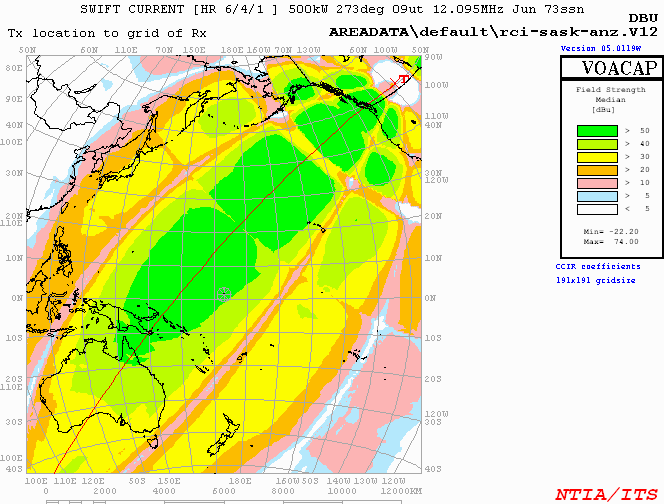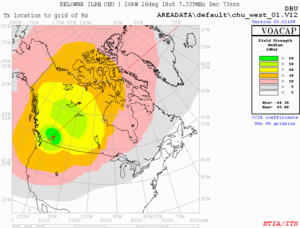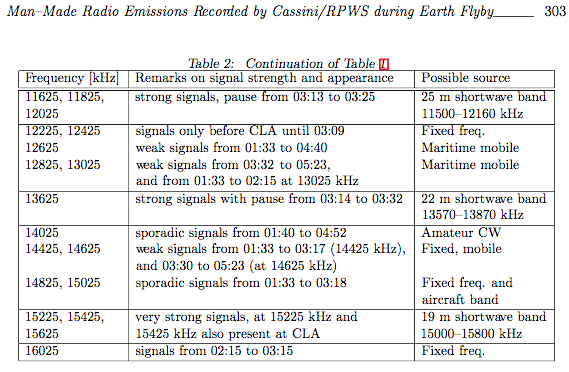Click tabs for
Radio Frequencies and the Environment
In this section we will look at the effects that radio frequencies RF have on the environment. First we see what the scientists are saying, then I'll go into the science of the process. There has been a growing concern among atmospheric scientists who have recognized the potential hazard that broadcasting can have on the magneto-ionosphere coupling and the environment. Click on section to go to source document or article
Polar Regions
[the ionosphere] "It is irradiated by the electromagnetic waves from the tens of thousands of broadcast, TV, utility and radar stations that are in use on the surface on the Earth. The radiated powers from the more powerful of these stations range from a few hundred kilowatts to a few megawatts. The handful of research radio facilities that use radio waves for studying the environment use the same type of transmitters with the same powers, but are so few that they contribute negligibly to the total man-made radiation"
Document Highlights
The upper atmosphere and the ionosphere is a boundary region between Earth and space which is subject to numerous interactions between the gas-plasma mixture and electromagnetic (EM) radiation. While the plasma in this region is generated mainly by the extremely high-frequency EM radiation (UV, X-ray) of solar origin, the relatively much lower frequency EM radiation of natural and anthropogenic origin, emanating from sources in the lower atmosphere (e.g., thunderstorms) and on the ground (e.g., radio transmitters), gives rise to plasma turbulence which, in turn, may generate EM radiation. The various kinds of radiation contribute to the overall, and ever increasing, “electrosmog.”
Document Highlights
The Science of AM Gyrofrequency Stimulation (Bailey Effect) [E layer ~1.45HMz]
(I will try to explain this as simply as I can without compromising a complex process)
Transmitter effects on the environment have been long researched and scientists see a picture emerging. A picture that says our environment is in danger from broadcast transmitters. Yet, out of air & radio pollution, while air pollution is the only one that is monitored and regulated, broadcasting of radio waves slips invisibly above us unregulated for it's effects on the environment and creates all kinds of chaos. The science of this process and it's path is a complex one and a story that has changed a few times in our history, but each and every change can be seen in the global temperature graph.
It begins with the gyro frequency at ~1.45MHz also known as the Bailey Effect after V.A. Bailey 1937/38.
One of the first clues I came across, through the SPS experiments, was that the frequency of the E layer of ionosphere (1.45MHz) happens to fall in the AM broadcast band. The ionosphere is a blanket of electrons and ions that surround the planet. Electromagnetic energy gives it energy and it heats up just like an electric blanket. This isn't your normal heat, this is electron or joule heating that can become unstable;
TSI (Thermal Self-focusing Instability) this and acoustic sound instabilities were observed: SBS & SRS
Those familiar with radio wave propagation and DX'ing know that 160 meters, which is close to the gyro frequency, is unique and unlike any other frequency in it's propagation characteristics.
"Basically, the electron gyro-frequency is a measure of the interaction between an electron in the Earth's atmosphere and the Earth's magnetic field. The closer a transmitted a medium frequency carrier or sideband wave frequency is to the electron gyro-frequency, the more energy that is absorbed by the gyro electrons from that carrier wave frequency. This is especially true for medium frequency signals traveling perpendicular to the Earth's magnetic field, meaning high latitude NW and NE propagation paths. Unfortunately this form of medium frequency signal absorption is ALWAYS present."
Gyro-Fact: The gyro frequency has unique thresholds for the onset of secondary instabilities
During experiments at the HAARP facility they found that ion cyclotron waves were stimulated better on and just above the second gyro-harmonic, but the higher harmonic multiples of the gyro frequency all create a suppression of the ion flow along the magnetic field line of ion acoustic turbulence. This is important to remember for later, you'll need to understand this to see it's potential significance in the global temperature anomalies graph, as this suppression can be seen in the temp drop of the 1940's when television came on the airwaves. Click for Source
There have been a chain of secondary instabilities in the atmosphere surrounding this gyro-frequency
The energy transferred through the gyro frequency rides two major instabilities that occur as you move up the electromagnetic frequency spectrum. The first is the cyclotron instability at ~1.45MHz and the second the cyclotron maser instability involving a non-thermal (microwave) bunching of the electromagnetic waves along the relativistic beam path. I remember learning about what microwaves actually do to heat the food. They cause the electrons in water molecules to vibrate rapidly creating heat, while electrons free of molecular bonds will begin to spin or spiral this can imbalance chemical reactions easily. I wondered if the gyro energy from AM radio could travel to the polar regions and somehow effect ozone holes. It does!
The Electrostatic Ion Cyclotron Instability [ ~1.45MHz - E layer - AM broadcast band ]
Another important condition that was crucial for the SEE can be explained in terms of charges in gyro motion around the Earth's magnetic field lines. Magnetic fields bend the paths of charges so they move perpendicularly to the field lines, i. e. in circles or spirals around the field lines, of which the frequency depends on the charge and the mass of the particle in question. Pump waves corresponding in frequency to these natural gyro motions of electrons tend to further accelerate the gyro motion, just like a forced harmonic oscillator. In the case of HF pumping this in the end leads to strong turbulence in the space plasma. Click for Source
The Electron Cyclotron MASER Instability [F layer ~ 30 - 220MHz] [ECMI ~ GHz maser]
(microwave amplification by stimulated emission of radiation)
The cyclotron maser instability may also be regarded simply as a growing space-charge wave in a relativistic beam which is in synchronism with the surrounding structure, or as due to current bunching, or even as an instability of the shear flow of a rotating relativistic electron fluid. Click for Source
gyro frequency range as the cyclotron energy jumps up (Luxembourg effect) from a 1.45MHz frequency to a higher relativistic energies along the magnetic field lines with O+ and H+ ions that flow to precipitate as electron showers into the lower atmosphere and not only act as a secondary form of ionization, and lightning, but might act as a source for long chain molecules. The cyclotron maser is used to heat radioactive plasma for energy in nuclear power plants and is used commercially to form and sustain long chain molecules similar to greenhouse gasses found in the atmosphere.
Electron-Cyclotron Maser Driven by Charged-Particle Acceleration from Magnetic Fieldaligned Electric Fields
This finding may necessitate reanalysis of some astrophysical radio sources and allow the electron-cyclotron maser to be applied to radio sources that have not been considered viable in the past ; for example, very bright, continuous sources or broadband sources. Parallel electric fields may be more widespread in astrophysical plasmas than currently believed. Click for Source
Luxembourg Effect ~ Cross Modulation
A Luxembourg effect is when two signals cross modulate causing a modified signal to jump to a higher frequency and can be seen in the Siple Station experiments in Antarctica. Here is an example where the frequency is seen to jump from 1.45kHz up to 3kHz. The energy will follow the easiest path, on the path of least resistance sometimes skipping up to a less busy band.
They were able to generate electron precipitation - EEP with 1 watt of power.
C
Click to Enlarge
Almost every VLF researcher has observed some HF radio broadcasts in their recordings.Three different RF receivers were used, spanning the frequency range 30 kHz to 30 MHz; although these could receive all kind of transmissions (CW, SSB, FM, AM, etc.), only AM broadcasts seemed to be detected in the VLF frequency range. A spectrum analyzer was used to investigate the power distribution across a broad frequency band (~1-10 Mhz). The available transmitter identifications showed that the distance to the transmitter was often quite long. Only one station at a time has usually been heard, showing that the process is very selective. It is also common that the event shows clear periodicity. Click for source
Human activity also can perturb Earth’s environment, but few are connected with controlled experiments in the ionosphere and are transient. Most of them are related to industrial activity and have increased in recent years. The most important power sources are broadcasting transmitters, power stations, power lines and heavy industry. At ionospheric altitude some disturbances and physical processes are related to seismic activity, thunderstorm activity and some global changes in the Earth environment
such as ozone holes.
Gyro Frequency Map
Document Highlights
DEMETER Micro-Satellite
At VLF frequencies between 10 and 20 kHz, the ground-based transmitters are used for radio-navigation and communications. Their ionospheric perturbations include: the triggering of new waves, ionospheric heating, wave-electron interactions, and particle precipitation. At HF frequencies, the broadcasting stations utilise powerful transmitters which can heat the ionosphere and change the temperature and the density. All these wave dissipations in the ionosphere could participate to the global warming of the Earth because the change in global temperature increases the number of natural lightning discharges in the atmosphere. Then the supplementary lightning discharges produce more magnetospheric whistlers which could produce heating and ionization in the lower ionosphere.
Furthermore, it is a feedback mechanism because two different processes could be involved. First, lightning is a source of NOx, and NOx affects the concentration of ozone in the atmosphere which contributes to the greenhouse effect. Second, precipitation of energetic electrons by man?made waves may trigger other lightning discharges.
It explains the importance of the study of such man-made waves
These are only a few of the many documents that I have collected reguarding this ozone depletion mechanism
Click here for more
1400 kHz Gyro Frequency
Earth's magnetic field passes through the ionosphere and exerts a force on ionospheric electrons that is proportional to their instantaneous velocities and to the component of the magnetic field at right angles to their directions of motion. The force direction is at right angles to the component of the magnetic field producing the deflecting force and also to electron motion directions caused by radio waves. The effect at high radio frequencies is to cause each electron to vibrate in an elliptical path and at low radio frequencies to vibrate in a loop. A crossover between elliptical and loop electron paths occurs at approximately 1400 kHz where each electron moves in a spiral path. That special frequency is called the gyro frequency.
Click for Source
Parrot reviewed power line harmonic radiation; spectral lines spaced 50-60 Hz apart in the magnetosphere and generally observed to drift in frequency. The "Sunday effect" had been used confirm an anthropogenic source (no natural 7-day period). He speculated on an atmospheric/ionospheric link between PLHR and the greenhouse effect (in addition to the usually quoted increase in CO2 emissions associated with power generation), which could increase in importance as electrical power consumption continued to increase. PLHR (Power Line Harmonic Radiation)
"Experimental results from three ionospheric HF pumping experiments in overdense E or F regions are summarized....It is suggested that two populations of charged particles are at play. One of them is the runaway population of electrons and ions from the ionosphere caused by the effects of the powerful HF radio wave. The other is the population of electrons that precipitate from the magnetosphere. It is shown that the hydrodynamical equilibrium was disrupted due to the effects of the HF pumping."
Hydrpdynsmical equilibrium is a factor in stratospheric ozone
"Raining" Electrons Contribute To Ozone Destruction"
Evidence shows electrons precipitating or 'raining' from Earth's magnetosphere are destroying ozone in the upper atmosphere.
Bailey Effect
Low Power 400-500W
Siple Station Experiments
Electrostatic ion cyclotron waves are the manifestation of this instability in the ionosphere as electrons and ions flow in a spiral motion along the E layer magnetic field lines which act as a density duct or wave-guide for the energy. The electron and ion cyclotron waves amplify as they travel toward the polar regions. (preferential amplification)
The enhancement in the spectral intensity is seen in two different characteristic frequency ranges. One is seen at odd half harmonics of the local electron cyclotron frequency in the range from 1.5 MHz to 3.5 MHz. The frequency range of these waves did not change with altitude as the local electron cyclotron frequency is almost constant in the orbit range of the rocket. Taking into account the observed frequency range and discrete peaks at odd half cyclotron frequencies, we explained these waves in terms of electron cyclotron harmonic (ECH) waves. Click for Source
Click to Enlarge
Click for Source
The presence of the cyclotron instabilities and their sensitivity to stimulation by the gyro frequency makes them greater paths for cyclotron energy. If you overdrive the ionospheres density with FM and television the conductivity increases allowing the suppressed cyclotron energy along the magnetic field line to jump and transfer to a higher gyroharmonic path So although the ion acoustic turbulence along the magnetic field line gets clamped by FM & TV, the energy will find a path of least resistance to the polar regions in the form of plasma cyclotron waves. It may be that it can find a lower path in the VLF range (20-30kHz also appears sensitive) or it could be that VLF waves are generated in the frequency jump process (aka SEE).
Up-shifted frequency electron-cyclotron current drive in a lower hybrid current drive plasma
Using oblique injection of electron-cyclotron (EC) waves, launched from the low field side of the WT-3 tokamak, into a target plasma sustained by lower hybrid current drive (LHCD), the plasma current is ramped up at a rate corresponding to 100 kA/s. The current ramp-up is ascribed to selective EC heating of tail electrons in the LHCD plasma via fundamental EC resonance at an up-shifted frequency due to the Doppler effect.
4th Gyro harmonic
SEE - Sweep thru
SEE - STIMULATED ELECTROMAGNETIC EMISSIONS
The Science of this Process - Parts & Process
The effects of radio frequencies on the ionosphere can be broken down into four major areas of relevance to understanding the path of energy in Broadcast Theory.
1.The transfer of energy from AM broadcast through the gyrofrequency and the generation of (EIC) electrostatic ion cyclotron plasma waves along the magnetic field line ducts.
2.Multiples of the gyrofrequency above the 2nd gyro harmonic cause a suppression of the EIC plasma waves along the magnetic field line.
3.Television and FM broadcast fall in this suppression band and cause hybrid waves that overdrive the ionosphere and increase the electron density.
4.The increase of electron density due to TV and FM act as a conductive bridge for the AM energy to jump to a higher cyclotron path.
1. Before we can develop a clear picture as to how the energy transfers through the ionosphere, we have to understand a few basics about the ionospheres’ structure and how it attenuates radio waves. The ionosphere is a blanket of electrons that surround the planet beginning at an altitude of about 65km which is known as the D layer of the ionosphere. This layer of the ionosphere absorbs the lowest frequencies from broadcast. As we move higher to about 100 km we find the E layer which absorbs the low – mid frequencies. Continuing higher the electron density drops into what is called the E valley and then climbs out and up to the F layer with the highest electron density that absorbs the higher frequencies from broadcast. Of all the frequencies that are absorbed two of them transfer their energy to the surrounding plasma and can get trapped in ionospheric density ducts. The gyrofrequency ~1.45MHz (cyclotron) and VLF. ~ 1.45MHz is the frequency of the E layer of the ionosphere itself and which falls in the AM broadcast band. Because of this the ionosphere reacts to AM broadcast like a tuning fork causing a forced oscillation. The co resonation acts as a bridge for the energy to pass from one to the other.
Before we can develop a clear picture as to how the energy transfers through the ionosphere, we have to understand a few basics about the ionospheres’ structure and how it attenuates radio waves. The ionosphere is a blanket of electrons that surround the planet beginning at an altitude of about 65km which is known as the D layer of the ionosphere. This layer of the ionosphere absorbs the lowest frequencies from broadcast. As we move higher to about 100 km we find the E layer which absorbs the low – mid frequencies. Continuing higher the electron density drops into what is called the E valley and then climbs out and up to the F layer with the highest electron density that absorbs the higher frequencies from broadcast. Of all the frequencies that are absorbed two of them transfer their energy to the surrounding plasma and can get trapped in ionospheric density ducts. The gyrofrequency ~1.45MHz (cyclotron) and VLF. ~ 1.45MHz is the frequency of the E layer of the ionosphere itself and which falls in the AM broadcast band. Because of this the ionosphere reacts to AM broadcast like a tuning fork causing a forced oscillation. The co resonation acts as a bridge for the energy to pass from one to the other.
Gyro frequencies cause electrons to spin in a spiral path at an accelerated rate. A good example of this is the use of the gyro frequency 2.45GHz to heat food in a microwave oven. As the electrons vibrate they generate heat. This is the same process that occurs in the ionosphere. Scientists have observed direct ionopsheric heating over areas of broadcast transmitters, particularly Europe and Asia. The electromagnetic energy from AM broadcast transfers its energy through the gyrofrequency in the form of electrostatic ion cyclotron plasma waves (EIC acoustic waves) that travel along the waveguide of the magnetic field lines.
“Unfortunately medium frequencies fall within or very near the electron gyro-frequency which is in the approximate range of 630 to 1630 kHz and of course the AM broadcast band and 160 meter band is very close to these electron gyro frequencies. There is a direct correlation between the strength of Earth's magnetic field lines and electron gyro frequencies.
Basically, the electron gyro frequency is a measure of the interaction between an electron in the Earth's atmosphere and the Earth's magnetic field. The closer a transmitted medium frequency carrier or sideband wave frequency is to the electron gyro frequency, the more energy that is absorbed by the gyro (spinning) electrons from that carrier wave frequency. This is especially true for medium frequency signals traveling perpendicular to the Earth's magnetic field, meaning high latitude NW and NE propagation paths. Unfortunately this form of medium frequency signal absorption is ALWAYS present.” (Page 34)
http://www.solar.spacew.com/cq/cqmar98.pdf
USA Gyrofrequencies fall in ~ 1200kHz - 1600kHZ
"The permanently pumped electromagnetic waves to the ionosphere by the system of broadcasting stations can disturb the nearest space environment. Thus this activity can create in the topside ionosphere local Langmuir turbulence or ion-acoustic turbulence. However theoretical assumptions show that the generation of ion-acoustic turbulence is far more effective.The scattering of super-thermal electrons on ion-acoustic or Langmuir turbulence is proposed as a mechanism of generation of broad-band HF emissions. The HF diagnostics, performed on the low orbiting satellite, detected an enhancement of radiation particularly over the Euro-Asia region. HF emission in the topside ionosphere is more intense over the area correlated with outer radiation belts."
https://www.earth-prints.org/bitstream/2122/823/1/18Rothkaehl.pdf
“The enhancement in the spectral intensity is seen in two different characteristic frequency ranges. One is seen at odd half harmonics of the local electron cyclotron frequency in the range from 1.5 MHz to 3.5 MHz. The frequency range of these waves did not change with altitude as the local electron cyclotron frequency is almost constant in the orbit range of the rocket. Taking into account the observed frequency range and discrete peaks at odd half cyclotron frequencies, we explained these waves in terms of electron cyclotron harmonic (ECH) waves.” (Page 45)
“The spectra measured in the HF frequency range onboard the Intercosmos-19, Cosmos-1809, ACTIVE, APEX and CORONAS-I satellites revealed unusual features suggesting a strong modification of the electron plasma in the topside ionosphere over densely populated areas of Europe and Asia. The location of broadband enhancements of about 20 dB relative to the cosmic noise over these areas is evident” (Pages 20 & 26)
Formation of artificial ionospheric ducts: https://agupubs.onlinelibrary.wiley.com/doi/full/10.1029/2008GL034630
"It is well known that strong electron heating by a powerful HF‐facility can lead to the formation of electron and ion density perturbations that stretch along the magnetic field line. Those density perturbations can serve as ducts for ELF waves, both of natural and artificial origin. This paper presents the first experimental evidence of plasma modifications associated with ion outflows due to HF heating."
2. Since we first discovered broadcasting technology we have been slowly turning up the dial using higher and higher frequencies starting with AM then moving onto FM and television. As our frequency use climbed to higher altitudes affecting higher layers of the ionosphere we breached the E layer of the ionosphere. Frequencies that were higher than the E layer would go through and reflect off the F layer back down to the E layer at an angle causing what is known as a ‘hybrid wave’ suppression of the EIC waves along the magnetic field line.
Since we first discovered broadcasting technology we have been slowly turning up the dial using higher and higher frequencies starting with AM then moving onto FM and television. As our frequency use climbed to higher altitudes affecting higher layers of the ionosphere we breached the E layer of the ionosphere. Frequencies that were higher than the E layer would go through and reflect off the F layer back down to the E layer at an angle causing what is known as a ‘hybrid wave’ suppression of the EIC waves along the magnetic field line.
“On 25 February 2004, HAARP was operated near the third and passed through the second gyro-harmonic for the first time in a weakening ionosphere. Two novel observations are: firstly, a strong enhancement of the artificial optical emission intensity near the second gyro-harmonic, which is opposite to higher gyro-harmonics; secondly, the optical enhancement maximum occurs for frequencies just above the second gyro-harmonic.” (Pages 40)
3. Between the E layer, which transfers 1.45MHz into EIC waves, and the F layer, that transfers the energy into EIC maser waves, there is a band of suppression and is stronger on each multiple of the gyro-harmonic above the 2nd. This causes a back up of the energy and the electron density and temperature increases. (see above)
Between the E layer, which transfers 1.45MHz into EIC waves, and the F layer, that transfers the energy into EIC maser waves, there is a band of suppression and is stronger on each multiple of the gyro-harmonic above the 2nd. This causes a back up of the energy and the electron density and temperature increases. (see above)
Example of gyro~harmonic suppression:
Excitation threshold and gyroharmonic suppression of artificial E region field‐aligned plasma density irregularities
"Ionospheric modification experiments have been carried out using the HAARP facility along with a 30 MHz coherent scatter radar imager in Alaska to examine properties of artificial E region field‐aligned plasma density irregularities (FAIs). In one set of experiments, the RF emission power was varied gradually in order to determine the threshold electric field for irregularity generation. A threshold O mode peak electric field amplitude of 170–195 mV/m at an altitude of 99 km and a heating frequency of 2.7 MHz was identified based on the full‐wave formalism of Thidé and Lundborg (1986). In another, the pump frequency was varied gradually to investigate the suppression of the FAIs at frequencies near the second electron gyroharmonic frequency (2Ωe). Coherent echoes were found to be suppressed for pump frequencies in an asymmetric band 40–50 kHz wide around 2Ωe but only for irregularities driven marginally above threshold. D. L. Hysell E. Nossa M. McCarrick Nov 2010" https://agupubs.onlinelibrary.wiley.com/doi/full/10.1029/2010RS004360
4. Furthermore the hybrid waves from FM and television also increase the electron density and overdrive the ionosphere. An effective way to understand this is to look at the E and F layers as conductive layers of an onion with nothing but a gap in between. If the gap is filled with electrons a bridge is created and the AM broadcast gyro frequency energy jumps to the F layer and EIC waves begin to flow over the area of suppression just like a dam that has too much water and overflows. This kind of energy transfer occurs when the E layer reaches a critical density then burst in the form of striations in the plasma that form into a flux transfer tube to the F layer which disrupts the ion acoustic turbulence. It can also be heard in VLF recordings.
Furthermore the hybrid waves from FM and television also increase the electron density and overdrive the ionosphere. An effective way to understand this is to look at the E and F layers as conductive layers of an onion with nothing but a gap in between. If the gap is filled with electrons a bridge is created and the AM broadcast gyro frequency energy jumps to the F layer and EIC waves begin to flow over the area of suppression just like a dam that has too much water and overflows. This kind of energy transfer occurs when the E layer reaches a critical density then burst in the form of striations in the plasma that form into a flux transfer tube to the F layer which disrupts the ion acoustic turbulence. It can also be heard in VLF recordings.
“Almost every VLF researcher has observed some HF radio broadcasts in their recordings. Usually the phenomenon has been interpreted as due to demodulation by non-linearities in the receiver electronics. Identification of the detected broadcasts was done by an experienced radio amateur. Three different RF receivers were used, spanning the frequency range 30 kHz to 30 MHz; although these could receive all kind of transmissions (CW, SSB, FM, AM, etc.), only AM broadcasts seemed to be detected in the VLF frequency range. A spectrum analyser was used to investigate the power distribution across a broad frequency band (~1-10 Mhz). The available transmitter identifications showed that the distance to the transmitter was often quite long. Only one station at a time has usually been heard, showing that the process is very selective. It is also common that the event shows clear periodicity. Usually demodulated signals seem to favour speech and "classical" music.” (Page 35)
“FAST satellite observations have now provided conclusive evidence that the electron-cyclotron maser driven by a shell instability is responsible for the coherent generation of AKR. This Ðnding may necessitate reanalysis of some astrophysical radio sources and allow the electroncyclotron maser to be applied to radio sources that have not been considered viable in the past ; for xample, very bright, continuous sources or broadband sources.” (Page 43)
I highly recommend the Document Highlights!
Click image to Enlarge
Note: In 1946 it was discovered that gyrofrequency stimulation of ionospheric plasma occurs using only 400 ~ 500 watts.
AM broadcast is limited to
50,000 watts.
This is how a Luxembourg effect
might look like as AM gyro energy finds a conductive path between the E & F Layers of the ionosphere.
Once the E layer reaches critical density a flux tube forms. This generates VLF waves.
Next click here
Research Sections
Polar Regions
Wikipedia
Middle Atmosphere Group
University Colorado Boulder
TIPER - Transmitter Induced EEP Stanford VLF
AARDDVARK Website
Auroral Zone - 1966
Next click here --
Polar Regions
Next click here
REP - Relativistic Electron Precipitation
EEP - Energetic Electron Precipitation
EPP - Energetic Particle Precipitation
TIPER - Transmitter Induced Precipitation of Electron Radiance
Kinds of Particle Precipitation
Click Link Below for Info
USA - AM band
Gyrofrequency
Nov - 1925: 536 Broadcast Stations
"The top load wire can increase radiated power by 2 to 4 times (3 to 6 dB) for a given base current."
https://en.wikipedia.org/wiki/T-antenna
Solar Power Satellite-SPS
Nonlinear Ionospheric Instabilities: SBS, SRS & TSI
SBS - Stimulated Brillouin Scattering:
This mechanism involves the nonlinear interaction of the EM pump and scattered EM and ion acoustic (ES) waves. Ion acoustic waves propagate at the ion sound speed which is typically a few hundred m s-1 in the ionosphere and have frequencies well below the
ionospheric plasma frequency, which is typically a few MHz.
The threshold power flux
level required to excite this process is given by (Fejer, 1979)
Pth (Wm−2) = (0.017Wm−2)(Ti /1000K)( f /1.0GHz) (3.1)
where Ti is the ion temp in the ionosphere and f is the EM pump frequency in GHz.
Under typical conditions in the upper ionosphere of Ti = 1000 K and at 2.48 GHz, the
Environmental impact of high power microwave beams
power threshold is only
0.04 W m-2 and so the SBS should be strongly excited by the SPS beam.
SRS - Stimulated Raman Scattering
This mechanism involves the nonlinear interaction of the EM pump and scattered EM and electron acoustic (ES) waves. Electron acoustic waves propagate at the electron sound speed which is typically a few tens of km s-1 in the ionosphere and at frequencies just above the local plasma frequency. The threshold power flux level required to excite this process is given by (Fejer, 1979)
Pth (Wm−2) = (4 ×10−5 Wm−2) (Ne /1012 m−3) 1/2(1.0GHz/ f ) (3.2)
Under typical ionospheric conditions with the electron density at 1012
m-3, the power flux
threshold is only 0.000016 W m-2. This again will be strongly excited in the ionosphere by
the SPS.
TSI - Thermal self-focussing instability:
This process was extensively studied in the context of SPS in the early 1980s (e.g. Duncan, 1981; Perkins and Goldman, 1981), in relation to potential environmental impact effects.
The power flux threshold given by Duncan (1981) for the TSI is:
Pth (Wm−2) = (0.43Wm−2)(1012 m−3 /Ne ) 3(Te /1000K)
4 ( f /1.0GHz) 3 (3.3)
where Te is the electron temperature in the ionosphere. There is a caveat on equation (3.3) and that is that strictly there is NO
absolute threshold for triggering the instability. An
assumption is made about how fast it needs to grow spatially along the beam direction under typical conditions.
The threshold is much more sensitive to condition parameters than
for either SBS or SRS. For typical conditions with an electron density of 1012
m-3 and an electron temp of 1500 K, the power flux threshold for a 2.48 GHz pump is 33 W m-2,
which means that the TSI would be excited by the SPS beam. Click for Source
It should be pointed out that as the TSI develops, plasma density irregularities are excited and self-focussing of the EM beam occurs where the electron density is reduced. This further enhances the temperature and pressure in the depletions which has the effect of further depleting the electron density, hence the instability. Although it is difficult to calculate the detailed structure of the developed interaction, it has been estimated that the
plasma density depletions will maximise at about 10% of the ambient density.
However, this may lead to self-focussing which locally increases the EM power density by a factor of 10
(Duncan, 1981)
This band can run hot due to AM broadcast band
well into the Gyro & cyclotron frequency range
Multiwire T broadcast antenna of early AM station WBZ, Springfield, Massachusetts, 1925
Optical signatures of radiation belt electron precipitation induced by ground‐based VLF transmitters
While the VLF transmitter signal may heat the ionosphere, it is not intense enough to directly excite optical emissions. If we assume that the VLF transmitter radiates isotropically (an upper limit since VLF transmitters primarily radiate laterally) and that the ionosphere at 100 km is in the far field (∼7λ for a 20 kHz transmitter), the electric field amplitude due to a 1 MW transmitter is only ∼80 mV m−1; ionization requires a minimum of ∼10 V m−1 in the ionosphere [e.g., Moss et al., 2006]. However, electrons precipitating due to pitch angle scattering by the transmitter will excite optical emissions.
Click for Source
Contrasting the efficiency of radiation belt losses caused by ducted and nonducted whistler‐mode waves from ground‐based transmitters
In this study we use loss cone observations from the DEMETER and POES low‐altitude satellites to focus on electron losses driven by powerful VLF communications transmitters. Both satellites confirm that there are well‐defined enhancements in the flux of electrons in the drift loss cone due to ducted transmissions from the powerful transmitter with call sign NWC.
The powerful U.S. Navy transmitter with call sign “NWC” (19.8 kHz, 1 MW radiated power, North West Cape, Australia, L = 1.45) is extremely well positioned to have a potential influence upon >100 keV electrons in the inner radiation belt; recent studies have confirmed that transmissions from this station lead to significant increases in drift loss cone energetic electron fluxes measured by low‐
Earth‐orbiting spacecraft [Sauvaud et al., 2008; Gamble et al., 2008]. The location of NWC is shown in Figure 1.
When contrasted with periods when NWC is nonoperational, there are typically ∼430 times more 100–260 keV electrons present in the drift loss cone across L = 1.67–1.9 due to NWC transmissions [Gamble et al.,2008].
Click for Source
Radiation belt precipitation by
man-made VLF transmissions
Enhancements of drift-loss cone fluxes in the inner radiation belt have been observed to coincide with the geographic location of the powerful VLF transmitter NWC. In this paper we expand upon the earlier study to examine the occurrence frequency of drift-loss cone enhancements observed above transmitters and the intensity of the flux enhancements and to demonstrate the linkage to transmitter operation. Our study has confirmed the strong dependence that these enhancements have upon nighttime ionospheric conditions. No enhancements were observed during daytime periods, consistent with the increased ionospheric absorption. We have also confirmed the persistent occurrence of the wisp features east of the NWC transmitter. The enhancements are initially observed within a few degrees west of NWC and are present in 95% of the nighttime orbital data east of the transmitter for time periods when the transmitter is broadcasting. No enhancements are observed when NWC is not broadcasting. This provides conclusive evidence of the linkage between these drift-loss cone electron flux enhancements and transmissions from NWC. When contrasted with periods when NWC is nonoperational, there are typically ∼430 times more 100–260 keV resonant electrons present in the drift-loss cone across L = 1.67–1.9 owing to NWC transmissions.
Click for Source
Additional Notes 2018/2019:
This is a section of ongoing learning, research and development
Artificial ducts caused by HF heating of the ionosphere by HAARP ~ 2.8MHz
In fact, the width of nighttime ducts reaches 200 km in the N-S direction versus 70–80 km of the daytime ducts. The density perturbation in the nighttime ducts
reaches 20–40%, while the daytime ducts are weaker than 15%.
The ducts seem to be produced most efficiently for heating frequencies quite close to the critical frequency foF2.
The heating builds up the plasma pressure, thus pushing plasma along the magnetic field.
https://spp.astro.umd.edu/SpaceWebProj/CV_PapaDoup_links/130_Artificial%20ducts%
20caused%20by%20HF%20heating%20of%20the%20ionosphere%20by%20HAARP.pdf
Sporadic E: Artificial Traveling Ionospheric Disturbances
Radar observations of artificial ionospheric turbulence during a magnetic storm
It is found that conditions for propagation of HF signals through the upper ionosphere at frequencies exceeding the maximum usable frequency for standard hop propagation through the F region were realized on the Irkutsk-“Sura” path in the presence of the powerful sporadic Es layer. The presence of such signals was revealed at the Rostov-on-Don station by receiving radio waves which escape from the altitudes of the ionospheric F region due to scattering by artificial small-scale magnetic-field-aligned irregularities. We studied the ionospheric effects of a magnetic storm occurring during the experiment by using the measurement data of the Doppler frequency shift of signals scattered by artificial ionospheric turbulence.
https://rd.springer.com/article/10.1007%2Fs11141-005-0002-0
TIPER: VLF Transmitter Induced Precipitation of Radiation Belt Electrons
Very Low Frequency (VLF) electromagnetic waves propagating in the magnetosphere are capable of interacting with trapped energetic electrons to remove them from the radiation belts. VLF waves propagating in the whistler mode can efficiently change the bouncing motion of energetic electrons if a certain gyroresonance condition is met between the wave and the particle's motion. A particle's motion can be modified so that instead of remaining trapped in the magnetic bottle of the magnetosphere, it precipitates upon the upper atmosphere where it will collide with the neutral particle population and lose its energy.
Some VLF waves are generated by natural phenomena, such as lightning, and these waves play a major role in controlling the radiation belt populations, but the waves can also be generated by man-made transmitters. A large antenna is required to efficiently radiate in the VLF range because the wavelengths are 10-100 km. Since longer wavelengths also penetrate greater distances into sea water, a number of powerful VLF transmitters have already been constructed for the purpose of Naval communication. These transmitters are located throughout the world and are almost always transmitting. Some of the VLF waves from these transmitters will leak through the ionosphere, couple into the magnetosphere, and gyroresonate with trapped particles leading to particle precipitation. This phenomenon is termed Transmitter-Induced Precipitation of Electron Radiation (TIPER). - Stanford University VLF Group
Richard M Thourne on Whistler Mode Waves 2014
The original 21.2 km long dipole antenna was driven by an 80 kW transmitter until it was eventually upgraded in the austral summer of 1978/1979 to a 150 kW transmitter [Carpenter and Bao, 1983]. The antenna itself was extended in the austral summer of 1982/1983 to 42 km, with a second perpendicular dipole of the same length installed over two austral summers from 1984 to 1986 [Gibby, 2008, pp. 19-20] in order to efficiently couple into the whistler-mode. By 1986, the Siple Station transmitter could radiate over 1 kW of ELF/VLF power, with antennas driven by a 150 kW source [Raghuram et al., 1974; Carpenter and Bao, 1983].
Radio waves from Earth clear out space radiation belt 9 June 2008 !
Naval Communication Station Harold E. Holt is located on the northwest coast of Australia, 6 kilometres (4 mi) north of the town of Exmouth, Western Australia.
Interestingly, the new work suggests researchers have never observed the Van Allen belts as they are “naturally”. That’s because VLF radio transmitters have been used since at least the 1920s to send telegraph messages and communicate with submarines, and the belts’ existence was only confirmed in 1958.
“Electron lifetime [in the belts] now must be different than it was before the transmitters were built, but we don’t know how different,” Rodger told New Scientist.
https://www.newscientist.com/article/dn14089-radio-waves-from-earth-clear-out-space-radiation-belt/
Electromagnetic Ion Cyclotron Waves for Radiation Belt Remediation Applications
The high-energy particles of the Van Allen belts coming from cosmic rays, solar storms, and man-made processes pose a risk to humans and spacecraft operating in those regions. These high-energy fluxes rapidly damage electronics, optics, and other systems. The radiation belt remediation (RBR) concept has been proposed as a way to solve this problem through ULF/VLF transmissions in the magnetosphere capable of precipitating these energetic particles into the atmosphere. This paper analyzes the effect of an RBR in-situ transmitter on inner belt energetic protons and outer belt electrons. This interaction requires the radiation of the left-hand polarized electromagnetic ion cyclotron (EMIC) band from space-borne antennas. The transmitter driving frequency and radiation pattern characteristics needed to drive the interaction are analyzed and applied to the calculation of individual test particles' scattering for different radiated power levels. The results show that the effect of the transmitter on individual loss cone particles is up to three orders of magnitude smaller for inner belt protons than outer belt electrons. While protons' scattering scales linearly with the wave field amplitude, electrons' scattering rapidly saturates because particles are being lost into the atmosphere. A radiated power flux of 10 -9 W/m 2 at the source would require three days of continuous interaction to scatter near loss cone inner belt protons by 1°, and 0.2 s in the case of outer belt electrons. If we increase the radiated power flux to 10 -5 W/m 2 , this interaction is reduced to 30 s for protons and 35 milliseconds for electrons. The engineering feasibility of EMIC transmitters is finally discussed;
https://ieeexplore.ieee.org/document/6522204
Radiation Belt Remediation Slideshow
Generation of ELF waves during HF heating of the ionosphere at midlatitudes
Modulated high frequency radio frequency heating of the ionospheric F-region produces a local modulation of the electron temperature, and the resulting pressure gradient gives rise to a diamagnetic current. The oscillations of the diamagnetic current excite hydromagnetic waves in the ELF range that propagate away from the heated region. The generation of the waves in the 2
– 10 Hz range by a modulated heating in the midlatitude ionosphere is studied using numerical simulations of a collisional Hall-magnetohydrodynamic model. To model the plasma processes in the midlatitude ionosphere the Earth’s dipole magnetic field and typical ionospheric plasma parameters are used. As the hydromagnetic waves propagate away from the heated region in the F-region, the varying plasma conditions lead to changes in their characteristics. Magnetosonic waves generated in the heating region and propagating down to the E-region, where the Hall conductivity is dominant, excite oscillating Hall currents that produce shear Alfvén waves propagating along the field lines into the magnetosphere, where they propagate as the electromagnetic ion cyclotron (EMIC) and whistler waves. The EMIC waves propagate to the ion cyclotron resonance layer in the magnetosphere, where they are absorbed.
https://ireap.umd.edu/sites/default/files/documents/muri2014/Publications/Sharma-2.pdf
On the statistical relation between ion upflow and naturally enhanced ion‐acoustic lines observed with the EISCAT Svalbard radar
We have investigated characteristics of ion upflow and naturally enhanced ion‐acoustic lines (NEIALs) based on the European Incoherent Scatter (EISCAT) Svalbard radar (ESR) data continuously obtained between March 2007 and February 2008. For the ion upflow study we have used approximately 78,000 field‐aligned profiles obtained with the ESR. For the NEIAL study we have identified approximately 1500 NEIALs in the ESR data at altitudes between 100 and 500 km. The occurrence frequency of ion upflow shows two peaks, at about 0800 and 1300 magnetic local time (MLT), while only one strong peak is seen around 0900 MLT for NEIALs. The upward ion flux also has only one peak around 1100–1300 MLT. The occurrence frequency of ion upflow varies strongly over season. It is higher in winter than in summer, whereas NEIALs are more frequent in summer than in winter. NEIALs frequently occur under high geomagnetic activity and also high solar activity conditions. Approximately 10% of NEIALs in the F region ionosphere were accompanied by NEIALs in the E region (occurred at altitudes below 200 km). About half of the E region enhanced echoes did not have an F region counterpart. Upshifted NEIALs dominate in the E region whereas downshifted NEIALs are usually stronger above an altitude of 300 km. The high occurrence frequency of NEIALs in the prenoon region (0800–1000 MLT) might be associated with acceleration of thermal ions to suprathermal ones. At the same MLT and geomagnetic latitude suprathermal ions and broadband extremely low frequency (BBELF) wave activity have been observed, according to previous studies.
https://agupubs.onlinelibrary.wiley.com/doi/10.1029/2010JA015827
1500 NEIAL per year / 12 months = 125 per mo.
125 per mo. / 30 days = 4.1 NEIAL's a day > JUST OVER EISCAT!!
Half of the E region NEIALs have F region NEIALs simultaneously. In other words, approximately 10% of NEIALs in the F region ionosphere are accompanied by NEIALs in the E region.
Furthermore, abundant heat flow from the magnetosphere causes high electron temperature (see green line in Figure 9a) and lowers the threshold to trigger NEIALs. In other words, background electron temperature and density, modulated by the soft electron precipitation and heat flow, affect the growth and decay rates of instabilities, and perhaps these instabilities lead to both suprathemal ion heating and thermal upflow as well as generating NEIALs in the radar data. Therefore it seems to us that rather than postnoon/midnoon it is the prenoon region where ion upflow is really connected to outflowing (escaping) ions.
Langmuir turbulence has been suggested to drive NEIALs by parametric decay [Forme, 1993], has been observed to decay to lower hybrid, possibly even ion‐acoustic waves [Stasiewicz et al., 1996], and might be a common driver of these phenomena.
(see Broadcast station induced Langmuir turbulence: https://www.earth-prints.org/bitstream/2122/823/1/18Rothkaehl.pdf)
Thus Transmitter > langmuir turbulence > NEIAL > EEP
[ESR: 500 MHz, and Tromsø UHF: 930 MHz]
Mystery of the Ionosphere’s “Gyro Line” Solved: A new study provides an updated hypothesis to describe a unique radar signature from plasma waves high above Earth, correcting errors that had stood for decades.
Although this signal is mostly smooth, its strength spikes at certain frequencies where various kinds of plasma waves in the ionosphere resonate and give the signal a boost. The plasma in motion can be either ions or electrons, each of which modulates the signal in different ways.
One of the most curious of these spectral spikes is the so-called gyro line, which appears as a signal shifted a fraction of a megahertz off the main radar frequency, depending on the plasma conditions.
In 1978 a seminal paper laid out a theoretical foundation for gyro lines, arguing they are caused by electrostatic whistler waves, in which electrons move back and forth. Using this foundation, an equation to predict the frequency of the gyro line for a given set of a conditions was produced. But many have noted over the years that it has limited success in predicting observations.
Now, in a new paper, Hysell et al. upend the conventional wisdom by correcting some significant errors in the original 1978 paper.
https://eos.org/research-spotlights/mystery-of-the-ionospheres-gyro-line-solved
An Experimental Study of Gyro Interaction In the Ionosphere at Oblique Incidence 1964
https://nvlpubs.nist.gov/nistpubs/jres/69D/jresv69Dn1p25_A1b.pdf
On the theory of the incoherent scatter gyrolines;
We therefore analyze the incoherent scatter gyroline feature computationally. The analysis is supported by range‐resolved incoherent scatter spectrograms measured recently at Arecibo. The gyroline feature is shown to be strongest in the midlatitude E and valley regions where the electron temperature is low enough to avoid cyclotron damping.
https://agupubs.onlinelibrary.wiley.com/doi/abs/10.1002/2017RS006283
Early GyroFrequency Experiments 1937 - 1963: The Bailey Effect
In 1937/38 V.A. Bailey predicted that broadcast stimulation of the ionospheric gyrofrequency could happen at a power of 1-2kW. Also known as the Bailey Effect.
In 1946 ionospheric plasma gyrofrequency stimulation was found to occur with only 400-500watts and magnified other RF signals passing through the modified E region by 4-10 times.
https://www.gpo.gov/fdsys/pkg/GOVPUB-C13-e91acf36c60a5ac43b304a37a08506b9/pdf/GOVPUB-C13-e91acf36c60a5ac43b304a37a08506b9.pdf?fbclid=IwAR2SG9Ryz3ofTOc0DxEaav3DAPCbiaqskllZczEv8ZArLSBw_0H0bqZaOT8
Roles of whistler mode waves and magnetosonic waves in changing the outer radiation belt and the slot region
Using the Van Allen Probe long‐term (2013–2015) observations and quasi‐linear simulations of wave‐particle interactions, we examine the combined or competing effects of whistler mode waves (chorus or hiss) and magnetosonic (MS) waves on energetic (<0.5 MeV) and relativistic (>0.5 MeV) electrons inside and outside the plasmasphere. Although whistler mode chorus waves and MS waves can singly or jointly accelerate electrons from the hundreds of keV energy to the MeV energy in the low‐density trough, most of the relativistic electron enhancement events are best correlated with the chorus wave emissions outside the plasmapause. Inside the plasmasphere, intense plasmaspheric hiss can cause the net loss of relativistic electrons via persistent pitch angle scattering, regardless of whether MS waves were present or not. The intense hiss waves not only create the energy‐dependent electron slot region but also remove a lot of the outer radiation belt electrons when the expanding dayside plasmasphere frequently covers the outer zone. Since whistler mode waves (chorus or hiss) can resonate with more electrons than MS waves, they play dominant roles in changing the outer radiation belt and the slot region. However, MS waves can accelerate the energetic electrons below 400 keV and weaken their loss inside the plasmapause. Thus, MS waves and plasmaspheric hiss generate different competing effects on energetic and relativistic electrons in the high‐density plasmasphere..
https://agupubs.onlinelibrary.wiley.com/doi/abs/10.1002/2016JA023634
Nonlinear reflection of a high-frequency radio wave by the ionospheric grating created by another wave
A powerful O-mode radio wave of frequency ω0, launched from a ground-based transmitter into the equatorial ionosphere, forms a standing wave pattern below the critical layer, heating the electrons with spatial periodicity. Subsequent ambipolar redistribution of plasma creates a density ripple. When another radio wave, of higher-frequency ω, is launched into the ripple region, the oscillatory electron velocity due to the ω wave couples to the density ripple to produce a nonlinear current that resonantly drives a reflected wave toward the Earth at frequency ω when k matching condition is satisfied. By this scheme one may reflect radio waves of frequency 20 times the maximum plasma frequency ωpmax of the ionosphere. In the case when the heater wave is mode converted into a plasma wave with Airy function profile, the nonuniform heating of electrons forms a nonuniform density grating of much shorter periodicity length. This grating may cause reflection of much higher frequency waves, however, with lesser amplitude.
https://www.researchgate.net/publication/260351496_Nonlinear_reflection_of_a_high-frequency_radio_wave_by_the_ionospheric_grating_created_by_another_wave
Luxembourg Effect
Low Power 600-800W
Overview of what scientists are saying!
A Puzzling Collapse of Earth's Upper Atmosphere 2008 !
July 15, 2010: NASA-funded researchers are monitoring a big event in our planet's atmosphere. High above Earth's surface where the atmosphere meets space, a rarefied layer of gas called "the thermosphere" recently collapsed and now is rebounding again.
"This is the biggest contraction of the thermosphere in at least 43 years," says John Emmert of the Naval Research Lab, lead author of a paper announcing the finding in the June 19th issue of the Geophysical Research Letters (GRL). "It's a Space Age record."
The collapse happened during the deep solar minimum of 2008-2009—a fact which comes as little surprise to researchers. The thermosphere always cools and contracts when solar activity is low. In this case, however, the magnitude of the collapse was two to three times greater than low solar activity could explain.
"Something is going on that we do not understand," says Emmert.
https://science.nasa.gov/science-news/science-at-nasa/2010/15jul_thermosphere
Advances in Theoretical Modeling of Earth’s Radiation Belts ~ 2018
https://vimeo.com/254024138
Cutting Edge of Radiation Belt Research ~ 2018
https://vimeo.com/254024023
Electromagnetic ion-cyclotron instability in the presence of a parallel electric field with general loss-cone distribution function – particle aspect analysis
The effect of parallel electric field on the growth
rate, parallel and perpendicular resonant energy and marginal stability of the electromagnetic ion-cyclotron (EMIC) wave with general loss-cone distribution function in a low β homogeneous plasma is investigated by particle aspect approach.
The effect of the steepness of the loss-cone distribution is investigated on the electromagnetic ion-cyclotron wave. The whole plasma is considered to consist of resonant and nonresonant particles. It is assumed that resonant particles participate in the energy exchange with the wave, whereas nonresonant particles support the oscillatory motion of the wave.
The wave is assumed to propagate parallel to the static magnetic field. The effect of the parallel electric field with the general distribution function is to control the growth rate of the EMIC waves, whereas the effect of steep loss-cone distribution is to enhance the growth rate and perpendicular heating of the ions. This study is relevant to the analysis of ion conics in the presence of an EMIC wave in the auroral acceleration region of the Earth’s magnetoplasma.
https://www.ann-geophys.net/24/1919/2006/angeo-24-1919-2006.pdf
Explaining the apparent impenetrable barrier to ultra-relativistic electrons in the outer Van Allen belt
Recent observations have shown the existence of an apparent impenetrable barrier at the inner edge of the ultra-relativistic outer electron radiation belt. This apparent impenetrable barrier has not been explained. However, recent studies have suggested that fast loss, such as associated with scattering into the atmosphere from man-made very-low frequency transmissions, is required to limit the Earthward extent of the belt. Here we show that the steep flux gradient at the implied barrier location is instead explained as a natural consequence of ultra-low frequency wave radial diffusion. Contrary to earlier claims, sharp boundaries in fast loss processes at the barrier are not needed. Moreover, we show that penetration to the barrier can occur on the timescale of days rather than years as previously reported, with the Earthward extent of the belt being limited by the finite duration of strong solar wind driving, which can encompass only a single geomagnetic storm.
In addition to chorus and hiss loss, there could also be additional losses arising from other wave modes such as electromagnetic ion cyclotron (EMIC) waves, which are neglectedin this model. For example, Drozdov et al.35 concluded that theeffects of EMIC waves may be required to limit the long-term fluxin the ultra-relativistic radiation belt. However, observationspresented by Usanova et al.36 show how the action of EMICwaves alone only impacts low equatorial pitch angle particles(where pitch angle is the angle between particle velocity and thebackground magnetic field) such that these waves acting alone arenot expected to be able to deplete the core of the distribution37,38.There could also be impacts from the action of chorus waveacceleration, as described, e.g., by Thorne et al.6. Although choruswaves may have an important role in the acceleration of electronsat relativistic energies39,40, at the ultra-relativistic energies (≳2MeV) examined here, the effects are expected to often berelatively weak41. Moreover, if additional chorus acceleration alsoprimarily acts close to the outer boundary of our simulations theinward ULF wave transport of this additional source of flux willbe captured in our model.
https://www.researchgate.net/publication/325067665_Explaining_the_apparent_impenetrable_barrier_to_ultra-relativistic_electrons_in_the_outer_Van_Allen_belt
The enhancement of EMIC waves always comes off the sunset side of the magnetopause right where the sun's ionization retreats to a in increase in the ionosphere's height.. what if.. as the vertical TEC and angular shift in the magnetic field between day/night side (low/high) favors the translation of MF/HF (AM) broadcast energy around the gyrofrequency range and parallel magnetic fields to the generation of EMIC waves.. such that it fuels plasmeric hiss.. the largest contributor to EEP electron losses.
The plasmapause morphology may contribute to inward ULF radial diffusion as the whole plasma field shifts in height.
When the Kp index gets high the gyrofrequency of a given geographical location fluctuates also allowing broadcast transmtters who've distanced their transmitters from broadcasting near the gyrofrequency to start unknowingly interaction with gyro-resonant particle populations.
Perhaps in increase in whistler mode waves and plasmeric hiss occur during solar quiet times because the F layer channel for cyclotron plasma waves is wider for maser like beams to form.. also due to parallel electric fields and an up shift in gyroresonant energy from the E layer of the ionosphere.
EMIC wave enhancements in the magnetosphere begin at dusk where the ionosphere looses ionization from solar rays and changes height coinciding with a spike in VLF signals. Perhaps the angle between night\day (high\low) provide ideal conditions for angular stimulation of gyroresonant particles and EMIC waves enhancements.
This theory is supported by Thorne at VERSIM 1996! (see end)
Furthermore fueling plasmeric hiss and radiation belt losses > EEP
If the angle of the high altitude of the night side ionosphere drops down during the day.. how do magnetic field ducts and parallel electric fields respond?
Higher Alt
90km
Lower Alt 70km - Ionization
Luxembourg Effect (Cross Modulation) ~ Angular amplification?
The gyrofrequency itself is in part determined by the height of the ionosphere. So although there may be a given gyrofrequency for a geographical location, the actual frequency shifts depending on day or night and VLF signals show a distinct spike just before sunrise as the ionosphere is ionized by solar radiation before the sun hits the earths surface.
Given that VLF signals experience a spike predawn, there's also reason to believe that gyrofrequency stimulation also is more effective around this time.
Experiments at HAARP show that gyrofrequency stimulation is strongest on or above the second harmonic of the gyrofrequency, so perhaps this combined with the declination of ionospheric ducting allows for super efficient transfer of energy from ground based broadcast transmitters and might contribute significantly to the generation of EMIC waves seen in the dawn sector of the magnetosphere.. which furthermore stimulates plasmeric hiss and electron losses to the loss cone of the polar vortex.
Perhaps it's through this channel that the magnetospheric electrons are accelerated to higher energies and will remain so until shocked by the solar wind.
It was discovered by V.A. Bailey that gyrofrequency stimulation (aka Bailey Effect) of the E region of the ionosphere, would amplify other radio waves propagating through the region of gyrofrequency stimulation.
It's important to realize that the predawn spike in VLF propagation is dependent on the height variation that is essentially in constant motion around the planet as the sun moves.. this channel for enhanced propagation is always present and moving over the landscape allowing VLF and gyrofrequency stimulation from transmitters to potentially excite EMIC waves in the magnetosphere.
The electron-cyclotron maser for astrophysical application.
Thus, in the presence of afield-aligned electric field component, there should exist an inner region in the distribution function at low energies that is void of particles (Chiu and Schulz1978).This latter prediction is not in agreement with observations which showed,instead, that the electron distribution exhibits a well-pronounced plateau at smaller velocities. Explaining this plateau involved considerable difficulties. It is clear by now that the plateau is not caused by a quasi-linear relaxation of the distribution through energy loss by electron–cyclotron maser emission. Instead,it was found to be caused by wave-particle interaction between the energetic electrons and low-frequency waves in the Very low-frequency range (LaBelleand Treumann 2002). These low-frequency waves are bound to the plasma and have no way to escape from it. Their excitation is unavoidable; it is intrinsic to the positive perpendicular velocity gradient in the undisturbed distribution function. Their intensity grows high enough to imprint on the electrons which are in resonance with the VLF waves and to deplete the gradient and gen-erate the plateau. In fact, artificially inhibiting the depletion of the gradient by taking out the VLF waves retains the gradient and leads to larger maser emissivity. Escaping free-space modes of the maser radiation are not intense enough to deplete the gradient, unless the radiation would be kept inside the maser source by some mechanism of confinement. Thus electric fields, particle acceleration, and VLF waves work together in producing auroral kilometric radiation as a most intense emission which can be understood only on the basisof the electron–cyclotron maser mechanism in the presence of a field-aligned electric potential drop.
This has been a most important realization of the last decade, and its consequence for astrophysical plasmas has yet to be exploited.
https://www.researchgate.net/publication/225382852_The_electron-cyclotron_maser_for_astrophysical_application [accessed Jan 15 2019].
Radio Noise in the Near Earth Environment: NASA
https://ntrs.nasa.gov/archive/nasa/casi.ntrs.nasa.gov/19900009307.pdf
Striated drifting auroral kilometric radiation bursts: Possible stimulation by upward traveling EMIC waves
Using electron particle data observed by HYDRA on board Polar, we have modeled the electron distribution function within the AKR source region. This distribution function is unstable to a number of low-frequency wave modes and supports EMIC waves propagating along the magnetic field line. These waves appear to be feasible to stimulate the growth of AKR, producing the ordered fine structure observed by WBD on board Cluster, but further analysis will be important, especially plasma simulations.
https://homepage.physics.uiowa.edu/~rlm/research/papers/2005JA011339.pdf
Observation of topside ionospheric MF/HF radio emission from space
S. D. Bale - Space Sciences Laboratory, University of California, Berkeley
Abstract. We present observations of MF/HF ionospheric
radio emission observed between 4-7 Re in the terrestrial
magnetosphere by the Wind spacecraft. During a perigee
pass, and AKR episode, two distinct radio signatures are
observed: an intense, sporadic emission near f .• 1.8 MHz,
and a more steady and weaker emission near f • 4.4 MHz.
These emissions show characteristics similar to ground observations of ionospheric 'auroral roar', although to propagate to the spacecraft they must have been generated above the ionospheric F-layer peak. We suggest that the emissions are generated on the topside ionosphere where the condition f•h • n fee is met. These observations represent a new component of the natural terrestrial radio spectrum as viewed from space.
Beginning at approximately 14:50 UT is a radio source
peaked at about 1.8 MHz; the emission is fairly intense, sporadic, and the peak frequency changes slightly with time.
This is labeled as 'MF Emission' in panel (c) of Figure
1.
The relatively sporadic and broadband nature of the
signal distinguishes it from man-made sources like those
visible near 1.5 MHz, beginning at 16:10 UT. Observed
shortwave radio transmitters tend to be very narrowband
(Sf/f • 0.001), constant frequency, and begin and end
transmission abruptly (often on UT hour boundaries). A
second component, beginning at about 15:30 UT, appears at near 4.4 MHz and is labeled 'HF Emission' in Figure 1. This signal is also relatively broadband, but weaker. If generated near local plasma resonances, these emissions must come from the topside ionosphere. There are no plasmas with fee and fpe at a few MegaHertz between the ionosphere and the solar corona; no interplanetary type II activity was observed on this day. The RAD1 and TNR spectograms (panels (b) and (c)) show concomitant AKR observations. During the interval of the observations in Figure 1, the spacecraft moves from 7 Re (0.78, 6.98,-0.33 GSE) to about 4.2 Re (-2.41, 3.45,-0.47 GSE). Spacecraft radial distance and local time (in fractional hours) are included on the abscissa in Figure 1.
https://agupubs.onlinelibrary.wiley.com/doi/pdf/10.1029/1999GL900048
Gyrofrequency Stimulation 1.5MHz observed between
4-7 Re in the terrestrial magnetosphere by the Wind spacecraft !!
Sub-ionospheric AKR: A possible mechanism for its transport down from the topside generation region to the F layer and ground
Recent theoretical work shows that "electron exhausts", elon-gated regions of depleted electron density shown by PICcodes to be generated in collisionless reconnection, can inprinciple become sources of X-mode Auroral Kilometric Ra-diation generated by the electron cyclotron maser instability(ECMI). In this paper it is suggested that under certain con-ditions such X-mode AKR can possibly be transported downalong the auroral magnetic flux tubes to low altitudes, in ex-treme cases even penetrating below the ionospheric F- andE-regions to reach ground level.
https://www.researchgate.net/publication/324104634_Sub-ionospheric_AKR_A_possible_mechanism_for_its_transport_down_from_the_topside_generation_region_to_the_F_layer_and_ground
Link between EMIC waves in a plasmaspheric plume and a detached sub‐auroral proton arc with observations of Cluster and IMAGE satellites
In this paper, we report observations from a Cluster satellite showing that ULF wave occurred in the outer boundary of a plasmaspheric plume on September 4, 2005. The band of observed ULF waves is between the He+ ion gyrofrequency and O+ ion gyrofrequency at the equatorial plane, implying that those ULF waves can be identified as EMIC waves generated by ring current ions in the equatorial plane and strongly affected by rich cold He+ ions in plasmaspheric plumes. During the interval of observed EMIC waves, the footprint of Cluster SC3 lies in a subauroral proton arc observed by the IMAGE FUV instrument, demonstrating that the subauroral proton arc was caused by energetic ring current protons scattered into the loss cone under the Ring Current (RC)‐EMIC interaction in the plasmaspheric plume. Therefore, the paper provides a direct proof that EMIC waves can be generated in the plasmaspheric plume and scatter RC ions to cause subauroral proton arcs.
https://agupubs.onlinelibrary.wiley.com/doi/full/10.1029/2010GL042711_region_to_the_F_layer_and_ground
Part of the working theory is that the angle of the ionospheric magnetic field at dawn/dusk in the direction of the ring current supports gyrofrequency stimulation of EMIC waves seen in the magnetosphere and that this also contributes to the plasmeric plume and hiss that's the leading mechanism for radiation belt electron losses.
Below is an example of the connection between EMIC waves and plasmeric plume.
In the research paper above on MF/HF signals in the topside ionosphere we can see shortwave broadcast in the gyrofrequency range as far as L~4/5 which is also at the altitude were we can see 4.2MeV electrons (see image below). Though most of the MeV electrons are due to solar storm activity.. when the Kp is high the range within which the gyrofrequency exists fluctuates and stimulation of EMIC waves may occur outside the non-storm time range. So for example gyrofrequency stimulation occurs between (630kHz ~(1.45MHz)~1630kHz) and is considered relatively static for a given location.
Is the fluctuation of gyrofrequency stimulation outside of the given frequency for a specific location considered with regards to it's possible effects in stimulating EMIC waves and subsequent contribution to plasmeric hiss which fuel radiation belt losses? Or is it merely considered with regards to it's effects on radio wave propagation and reception?
Do we take into consideration the angle of the magnetic field in the dawn/dusk ring current and it's effect on increasing signal propagation as seen with VLF signals?
VLF signal spike at dusk
VLF Induced EEP Slideshow
https://slideplayer.com/slide/8456821/
https://pdfs.semanticscholar.org/d476/6dc9400c742b9d31a8dddc52ff0623addf4b.pdf
VERSIM - XXV General Assembly of URSI, Lille, August-September 1996
Whistler-mode waves and their effects on the radiation belts
This was a very successful session which attracted a large audience. The focus was on the resonant cyclotron pitch angle scattering of trapped electrons by whistler mode waves, and the importance of the latter as a loss mechanism. The three invited speakers (Thorne, Vampola, Walt) reviewed the current theoretical and experimental knowledge.
Thorne reported modelling work with Abel which showed that Coulomb scattering was an effective loss mechanism only for L<1.2. Except for pitch-angles very close to 90°, where Landau resonance was important, pitch angle scattering by cyclotron resonance was the dominant process in determining electron lifetimes over essentially all of the radiation belts. Using estimates of whistler mode wave intensity distributions and spectra in different regions, it was estimated that signals from VLF transmitters were most important in the inner region, hiss in the outer region, and lightning whistlers in the intermediate region.
Vampola reviewed the satellite evidence on the scattering of resonant electrons into the drift loss cone by powerful VLF transmitters. The frequency, modulation format and particularly longitude were all important factors. One of the most effective transmitters had been the Soviet UMS transmitter. The precipitation patterns around each transmitter and its conjugate, formed by scattering into the bounce loss cone, were also discussed. The "natural" radiation belts in the absence of VLF transmitters have never been observed and it is an intriguing question what the effect will be if/when all the VLF transmitters are turned off.
Manninen reported on observations of VLF waves and aurorae made during three 2-3 week campaigns at quiet sites in Northern Finland near L=6. He also reported artificial VLF signals observed during magnetically disturbed times which were apparently due to the ionospheric cross-modulation of high power short wave broadcasts.
Man-made phenomena
Almost every VLF researcher has observed some HF radio broadcasts in their recordings. Usually the phenomenon has been interpreted as due to demodulation by non-linearities in the receiver electronics. Identification of the detected broadcasts was done by an experienced radio amateur. Three different RF receivers were used, spanning the frequency range 30 kHz to 30 MHz; although these could receive all kind of transmissions (CW, SSB, FM, AM, etc.), only AM broadcasts seemed to be detected in the VLF frequency range. http://www.physics.otago.ac.nz/versim/versim04.html
During the VERSIM meeting of 1996.. Thorne clearly states that pitch angles of 90°, where Landau resonance is important, pitch angle scattering by cyclotron resonance is the dominant process in determining electron lifetimes over essentially all radiation belts.
The pitch angle of the dusk magnetic field in the direction of the ring current is most likely ~90°.. which would indeed favor cyclotron resonance and gyrofrequency stimulation.
He also states that VLF transmitters were most important in the inner region AND outer region --> plasmeric hiss <-- !!
Later in this same meeting they discuss Man-made phenomena and how AM broadcast can be heard routinely in VLF receivers.
All of this supports the theory that gyrofrequency stimulation can indeed play a role in some of the most dominant processes of radiation belt losses.
EMIC
Double click here to add text.
EMIC
In the section below we include more recent research and look at how broadcast induced gyrofrequency stimulation in the dusk side of the ionosphere may contribute to the natural EMIC waves and plasmeric hiss that fuel the EEP-NOx ozone depletion mechanism.
Ionospheric Heating Slideshow
http://slideplayer.com/slide/4315612/
Below is an example of gyrofrequency boost and this radiation belt particle acceleration as observed by the Van Allen Storm Probes
See: Bailey Effect
400 ~ 500W
May also apply to gyrofrequency
Electron acceleration in the heart of the Van Allen radiation belts
The Van Allen radiation belts contain ultrarelativistic electrons trapped in Earth's magnetic field. Since their discovery in 1958, a fundamental unanswered question has been how electrons can be accelerated to such high energies. Two classes of processes have been proposed: transport and acceleration of electrons from a source population located outside the radiation belts (radial acceleration) or acceleration of lower-energy electrons to relativistic energies in situ in the heart of the radiation belts (local acceleration). We report measurements from NASA's Van Allen Radiation Belt Storm Probes that clearly distinguish between the two types of acceleration. The observed radial profiles of phase space density are characteristic of local acceleration in the heart of the radiation belts and are inconsistent with a predominantly radial acceleration process.
http://science.sciencemag.org/content/341/6149/991
On the theory of the incoherent scatter gyrolines
The incoherent scatter spectrum feature referred to as the “gyroline” is investigated theoretically and experimentally. The gyroline is associated with the dispersion relation for electrostatic whistler waves. Earlier treatments by Trulsen and Bjørna (1978, and references therein) derive the frequency and growth rate for these waves, but their derivation is only accurate for very small magnetic aspect angles, i.e., for wave vectors close to perpendicular to the geomagnetic field. Their expression for the frequency has the form of a low‐order Padé approximate, but we find that a simple formula of this kind accurate for arbitrary magnetic aspect angles does not exist. We therefore analyze the incoherent scatter gyroline feature computationally. The analysis is supported by range‐resolved incoherent scatter spectrograms measured recently at Arecibo. The gyroline feature is shown to be strongest in the midlatitude E and valley regions where the electron temperature is low enough to avoid cyclotron damping.
https://agupubs.onlinelibrary.wiley.com/doi/abs/10.1002/2017RS006283
This gyroline boost to the generation of whistler mode waves was originally known as the Bailey Effect. V.A.Bailey predicted in 1938 that gyrofrequency stimulation in the ionosphere would occur at 1 - 2 kW of transmitter power.. however in 1946 it was verified by experimental observation that it only required 400 - 500 watts.
AM broadcast is transmitted at and limited to 50,000 watts.
E Layer Critical Freq Maps
Near-Real-Time E-Layer
Critical Frequency Map
http://spacew.com/www/foe.html
When Electromagnetic Ion Cyclotron: EMIC waves reach the threshold for Electron Cyclotron Maser Instability: ECMI, they generate Electron Cyclotron Maser: ECM waves in the X-mode.
An interferometer experiment to explore the aspect angle dependence of stimulated electromagnetic emission spectra
When the Earth’s ionosphere is irradiated by a radiofrequency (RF) electromagnetic wave of sufficiently high power density and tuned to match a natural E- or F-region plasma frequency, ionospheric magnetoionic wave modes may be excited and may generate RF electromagnetic sideband waves via nonlinear interactions. These secondary emissions, which may then escape from the ionosphere, have been termed stimulated electromagnetic emission or SEE. The frequency spectra of this radiation has been studied extensively, and a number of characteristic spectral
features have been identified and in some cases related to particular plasma processes. The separation in frequency between the RF pump and the harmonics of the local electron gyrofrequency is critical in determining the amount of anomalous absorption suffered by the pump wave and the spectral properties of the stimulated sidebands. The pump can excite electrostatic waves which do not propagate away but can in some cases be observed via radio-wave scattering from the electron density fluctuations associated with them. These enhanced density fluctuations are created by processes commonly referred to as upper-hybrid and Langmuir turbulence. Langmuir turbulence has been the subject of 930-MHz scattering observations with antenna scanning through several pre-selected angles between the geographic and geomagnetic zenith directions, and a preference
for pointing angles between the Spitze angle and geomagnetic field-aligned was identified. https://hal.archives-ouvertes.fr/hal-00317485/document
The Low-Latitude Ionosphere/Thermosphere Enhancements in Density (LLITED) Mission 2017
Recent observations of the duskside thermosphere have revealed additional complexity in the coupling between the ionosphere/thermosphere (IT) regions and its potential impact on space weather. There exists two dominant IT interactions in the low-latitude dusk-side: the Equatorial Ionozation Anomaly (EIA) and the Equatorial Temperature and Wind Anomaly (ETWA).
ETWA AND EIA
The low altitude nighttime IT region (100-500) contains large scale features and a host of phenomena including space weather driven events such as Equatorial Spread-F and scintillation. Two prominent features of the region are the EIA & ETWA, which occur to some extent in all longitudes within +/-40* geographic latitude.
EIA consists of regions of enhanced plasma density on either side of the equator and were first discovered by Namba and Maeda. Over time the EIA has been extendively sudied using observations from the varried array of platmforms ranging from ground based ionosonde and GPS radio occultation. The formation of the EIA, especially during when plasma at the equator is driven upward via the vertical ExB drift, and then diffuses to lower altitudes along geomagnetic field lines. This is also known as the "fountain effect". The variability of the EIA, especially during geomagnetic activity, may provide conditions conducive to various space weather events.
The ETWA is identified by enhancements in the thermosphereic neutral temperature and neutral densities that while occuring at low latitudes, also occur at latitudes slightly higher than EIA. Neutral density enhancements and troughs were originally observed using sensor data from OVE-6 and DE-2 satellites. Unlike the EIA, the ETWA is less understood and observations are rarely scarce.
Over the years, a number of studies have proposed mechanisms to explain the formation of the ETWA. The first hypothesis describing the ETWA daytime formation involved formations in zonal ion drag as a function of latitude producing enhancements in neutral temperature and density. This variation results in energy flow from the dayside to the nightside being damped at EIA crest latitudes producing enhancements in neutral temp and density.
The COSMIC mission, a constellation of six satellites each with a GPS radio occultation reciever, provided between 2000-3000 occultations (slant TEC) per day between 2007 - 2012. This data provides reasonable global coverate of the ionosphere for average periods of a day or more. Luan et al. found that EIA was clearly identifiable throughout the day/night in the TEC data.
The mission is to provide both ionosphere and thermosphere measurements related to the Equatorial Ionization Anomaly (EIA) and the Equatorial Temperature and Wind Anomaly (ETWA). The EIA and ETWA are two of the dominant ionosphere/thermosphere interactions on the low-latitude duskside. While the EIA has been extensively studied both observationally and with modeling, the ETWA is less well known since observations are infrequent due to a lack of suitably instrumented spacecraft (s/c) at appropriate altitudes. LLITED will, for the first time, provide coincident high-resolution measurements of the duskside ionosphere/thermosphere at lower altitudes that will characterize and improve our understanding of the ETWA, provide insight into the coupling physics between the ETWA and EIA, and increase our knowledge of the duskside dynamics that may influence space weather.
https://digitalcommons.usu.edu/cgi/viewcontent.cgi?article=3697&context=smallsat
Broadcast in the VLF and gyrofrequency range fuels EMIC waves through the Equatorial Ionization Anomaly EIA and the Equatorial Temperature and Wind Anomaly ETWA and the angle in which the gyrofrequency EMIC/ECMI amplification occurs is observed as a slant in the TEC.
Our allocation of AM broadcast powers don't take into consideration how it may be generation EMIC waves that fuel plasmeric plume and hiss to eventually stimulate EEP-NOx and cause variations in Total Electron Content TEC and stratospheric ozone depletion.. Thus affecting the climate and it's heat budget.
Stimulated Electromagnetic Emission: SEE
Sweep through the 4th gyroharmonic
Through the ionospheres shifting morphology, at some point the EIA wave crest is going to find itself at an angle that interacts with radio waves it's being subject to and side band stimulated Electromagnetic Emission SEE may occur.
During solar storms all kinds of plasmeric bubbles, fountains and blobs form in this dusk region.
Broadcast Theory suggests this region is prone to anthropogenic space weather effects due to broadcast induced plasma turbulence and subsequent EEP-NOx.
The gyroline is associated with the dispersion relation for electrostatic whistler waves. Earlier treatments by Trulsen and Bjørna (1978, and references therein) derive the frequency and growth rate for these waves, but their derivation is only accurate for very small magnetic aspect angles, i.e., for wave vectors close to perpendicular to the geomagnetic field. https://agupubs.onlinelibrary.wiley.com/doi/full/10.1002/2017RS006283
WEP Schematic.
WEP Deposition
Whistler Wave Packet
Transmitter Induced EMIC - Whistler waves in EIA/ETWA region at dusk
Polar Regions
Next click here
Bailey Effect
Rocket Experiment
An electromagnetic propagation tool for signal scintillation reproduction based on derterministic ionospheric medium
It is usually assumed that the scintillations observed on signals propagating through the ionosphere are linked to the occurrence of bubbles inside the medium. Based on such medium description, the purpose of this paper is to propose an electromagnetic propagation tool able to reproduce the signal scintillation due to the ionosphere.
http://www.pstep.jp/template/pstep3-abstract.html
A brief review of equatorial ionization anomaly and ionospheric irregularities
Following a brief history and progress of ionospheric research, this paper presents a brief review of the recent developments in the understanding of two major phenomena in low and mid latitude ionosphere—the equatorial ionization anomaly (EIA) and involved equatorial plasma fountain (EPF) and ionospheric irregularities.
Ionospheric Irregularities
3.1 Introduction
The ionosphere has a smooth density distribution during daytime. In other words, during daytime when the E‐region conductivity is strong, ionospheric drivers such as neutral winds and electric fields and their fluctuations cannot win in producing irregularities in the ionosphere. But after sunset when the E‐region conductivity becomes weak, the drivers can generate plasma irregularities of various scale sizes ranging from centimetres to hundreds of kilometres that manifest as spread‐F in ionograms (Booker and Wells, 1938) and plasma bubbles in radar maps (Woodman and Lahoz, 1976) and optical images (Weber et al., 1978). Radio waves propagating through such an irregular ionosphere undergo sporadic enhancement and fading known as scintillations (e.g., Booker, 1956) which affect communication and navigation systems when scintillations are strong.
Using the incoherent scatter (IS) radar at the equatorial station Jicamarca, Woodman and La Hoz (1976) for the first time reported plasma density depletions extending beyond the ionospheric peak in the region of strong ESF. They interpreted the depletions as the bottom‐side irregularities evolving nonlinearly into the topside ionosphere while forming bubble‐like structures or equatorial plasma bubbles or EPB.
The radar data show the plasma irregularities originated in the bottom‐side raising to high altitudes and evolving into the topside forming bubble‐like structures extending sometimes over 700 km height. It also seems to indicate that the irregularities originating at E‐region heights pass through the ‘forbidden’ region of very low plasma density, which the radar seems unable to detect.
Intense ionospheric irregularities develop in the post‐sunset bottom‐side equatorial ionosphere when it rises to high altitudes, and evolve nonlinearly into the topside. Pre‐reversal enhancement (PRE) of the vertical upward E×B drift and its fluctuations amplified during PRE provide the driving force and seed, with neutral wind and gravity waves being the primary sources. At low solar activity especially in summer when fast varying PRE is absent, the slow varying gravity waves including large scale waves (LSW) seem to act as both driver and seed for weak irregularities. At mid latitudes, the irregularities are weak and associated with medium scale traveling ionospheric disturbances (MSTIDs).
The general features of the irregularities are listed here.
● Plasma irregularities generally occur after ~19:30 LT and continue for about an hour to several hours and sometimes until sunrise.
● Post‐sunset irregularities are frequent, intense and last longer centered around the magnetic equator at equinoxes especially at high solar activity.
● In summer and at low solar activity, weak irregularities generally occur after midnight.
● The irregularities usually start appearing in the bottom‐side ionosphere when it raises above a threshold height that varies with various geophysical conditions.
● The irregularities quickly rises to high altitudes well beyond the ionospheric peak, sometimes over 2000 km at the equator.
● As the irregularities rise in height they become aligned along the geomagnetic field lines covering up to ±30° magnetic latitudes in extreme cases.
● The irregularities usually drift eastward with velocity of 100 to 200 m·s–1.
● The irregularities causing spread‐F can originate at latitudes away from the equator though they do not result in plasma bubbles.
● Geomagnetic activity intensifies the irregularities in some cases and inhibits them in other cases.
https://agupubs.onlinelibrary.wiley.com/doi/full/10.1002/2017RS006283
Filamentary Alfvenic structures excited at the edges of equatorial plasma bubbles
Recent observations performed by the French DEMETER satellite at altitudes of about 710 km suggest that the generation of equatorial plasma bubbles correlates with the presence of filamentary structures of field aligned currents carried by Alfven waves. These localized structures are located at the bubble edges.
https://www.ann-geophys.net/25/2159/2007/angeo-25-2159-2007.pdf
Self-consistent model of magnetospheric ring current and propagating electromagnetic ion cyclotron waves: Waves in multi-ion magnetosphere 2006
The effect of electromagnetic ion cyclotron (EMIC) waves on the Earth’s ring current (RC) dynamics is one of the best known examples of wave-particle interaction, and at the same time it is the most controversial mechanism of RC loss [Walt and Voss, 2001, 2004]. As a rule, the effective temperatures of RC ions transverse to, T?, and along, Tk, geomagnetic field line comply with an inequality T? > Tk. If an ion temperature anisotropy, A = T?/Tk 1, exceeds some positive threshold, EMIC waves could be generated [Cornwall, 1964, 1965; Kennel and Petschek, 1966]. These waves have been observed in the inner [e.g., LaBelle et al., 1988; Erlandson and Ukhorskiy, 2001] and outer [Anderson et al., 1992a, 1992b] magnetosphere, at geostationary orbit [Young et al., 1981; Mauk, 1982], at high latitudes along the
plasmapause [Erlandson et al., 1990], and at ionospheric altitudes [Iyemori and Hayashi, 1989; Bra¨ysy et al., 1998].
https://science.gsfc.nasa.gov/673/staff/bios/cs/KhazanovGV/2006JA011833.pdf
Oulo Space Physics Textbook
EMIC - Textbook
The width of nighttime ducts reaches 200 km in the N-S direction versus 70–80 km of the daytime ducts. The density perturbation in the nighttime ducts
reaches 20–40%, while the daytime ducts are weaker than 15%
Observations of coincident EMIC wave activity and duskside energetic electron precipitation on 18–19 January 2013
Electromagnetic ion cyclotron (EMIC) waves have been suggested to be a cause of radiation belt electron loss to the atmosphere. Here simultaneous, magnetically conjugate measurements are presented of EMIC wave activity, measured at geosynchronous orbit and on the ground, and energetic electron precipitation, seen by the Balloon Array for Radiation belt Relativistic Electron Losses (BARREL) campaign, on two consecutive days in January 2013. Multiple bursts of precipitation were observed on the duskside of the magnetosphere at the end of 18 January and again late on 19 January, concurrent with particle injections, substorm activity, and enhanced magnetospheric convection. The structure, timing, and spatial extent of the waves are compared to those of the precipitation during both days to determine when and where EMIC waves cause radiation belt electron precipitation. The conjugate measurements presented here provide observational support of the theoretical picture of duskside interaction of EMIC waves and MeV electrons leading to radiation belt loss.
https://agupubs.onlinelibrary.wiley.com/doi/full/10.1002/2015GL065245#grl53223-note-0001
Alexa Halford - Space Physicist Blog
http://alexahalford.weebly.com/space-physics/category/all/6
Precipitation of inner zone electrons by whistler mode waves from the VLF transmitters UMS and NWC 1981
The precipitation of energetic electrons which are commonly observed in the drift loss cone east of 60° east longitude between L ∼1.6 and L ∼1.8 can be accounted for by a Doppler‐shifted cyclotron resonance between the electrons and nonducted whistler mode waves from high‐power, ground‐based VLF transmitters. A ray‐tracing analysis using a diffusive‐equilibrium model shows that 17.1‐kHz waves starting with vertical wave normals between 23° and 31° magnetic latitude cross the magnetic equator between L ∼1.6 and f L ∼1.8 with wave normals of approximately 63°. A relativistic cyclotron‐resonance analysis for the same model plasmasphere using the ray‐tracing results gives an energy versus L shell dependence for the precipitated electrons which is in excellent agreement with the observed dependence. The primary VLF transmitter is most probably the UMS transmitter located near Gorki, USSR. It transmits on 17.1 kHz. VLF records covering this frequency band were available for only three of the time periods when electrons were observed. In two cases UMS was transmitting at the time required to account for the observations. In the third case a higher frequency is required to fit the data. At the time, the NWC transmitter at North West Cape, Australia was operating at 22.3 kHz. These data are consistent with a model in which weak pitch angle scattering by whistler mode waves from NWC does not completely fill the drift loss cone at the longitude of NWC.
https://agupubs.onlinelibrary.wiley.com/doi/pdf/10.1029/JA086iA02p00640
Shortwave Broadcasting Curtain Arrays
Curtain arrays are a class of large multielement directional wire radio transmitting antennas, used in the shortwave radio bands.[1] They are a type of reflective array antenna, consisting of multiple wire dipole antennas, suspended in a vertical plane, often in front of a "curtain" reflector made of a flat vertical screen of many long parallel wires.[1] These are suspended by support wires strung between pairs of tall steel towers, up to 300 ft (90 m) high.[1] They are used for long-distance skywave (or skip) transmission; they transmit a beam of radio waves at a shallow angle into the sky just above the horizon, which is reflected by the ionosphere back to Earth beyond the horizon. Curtain antennas are mostly used by international short wave radio stations to broadcast to large areas at transcontinental distances.[1]
Because of their powerful directional characteristics, curtain arrays are often used in government propaganda radio stations to beam propaganda broadcasts over national borders into other nations. For example, curtain arrays were used by Radio Free Europe and Radio Liberty to broadcast into Eastern Europe.
https://en.wikipedia.org/wiki/Curtain_array
EMIC wave association with gepmagnetic storms, the plasmasphere, and the radiation belts
Halford, Alexa J. - University of Newcastle Research Higher Degree Thesis - 2012
Electromagnetic Ion Cyclotron (EMIC) waves have recently been considered an important process in the magnetosphere and in particular contribute to electron loss in the radiation belts. Here we describe the characteristics of EMIC waves under different magnetospheric conditions, their relationship to the plasmasphere and plasmaspheric plumes, and start examining the ability of EMIC waves to resonate with radiation belt electrons using data from the Combined Release and Radiation Effect Satellite (CRRES). Due to the lack of coverage around noon, the majority of EMIC waves were found to occur in the dusk sector at MLT = 15 hr and at L = 6. The highest occurrence rates for EMIC waves occurred during the main phase of geomagnetic storms, when it is expected that there may be overlap between the cold plasmaspheric plasma and the hot ring current plasma.
The role of the cold plasmaspheric plasma has been examined. It was found that EMIC waves were observed in regions with enhanced cold plasma densities under all magneto- spheric conditions except for the pre-onset phase of a geomagnetic storm, which may be due to the small number of events. This is consistent with the idea of plasmas- pheric plumes forming during this phase.
EMIC waves have been suggested as a mechanism for electron particle loss in the radiation belts. It was found that for electrons with energies of 1.25 - 10 MeV, there were EMIC wave events where the pitch angle diffusion extended into the loss cone. It is expected that after bounce averaging the diffusion coefficients will exceed the strong diffusion regime under most magnetospheric conditions for electron energies between 1.25 and 2 MeV. On average the highest diffusion coefficients were observed during the main phase of geomagnetic storms. CRRES has greatly increased the communities understanding of EMIC waves and their role within the Earth-Space environment. It has been shown where and when to expect to see these waves, how plumes, but more importantly enhanced cold plasma den- sities, play a large role in EMIC wave occurrence, and how EMIC waves are able to resonate with radiation belt electrons contributing to the main phase loss in the radiation belts.
http://alexahalford.weebly.com/space-physics/category/all/6
WIND/WAVES observations of man-made radio transmissions
The WAVES radio and plasma wave instrument on the Wind spacecraft, launched on November 1, 1994, has detected copious shortwave radio transmissions from broadcast stations on Earth. WAVES can easily detect signals consisting of only a few kW of transmitted power, suggesting that useful ionospheric propagation research can be accomplished with very modest equipment. We also conclude that the terrestrial radio spectrum is quite “non natural” so that any extraterrestrial radio astronomer should easily deduce that Earth is populated with a civilization with technical capabilities..
https://www.researchgate.net/publication/256848249_Man-made_radio_emissions_recorded_by_Cassini_RPWS_during_Earth_flyby
DEMETER observations of manmade waves that propagate in the ionosphere
DEMETER was an ionospheric micro-satellite in operation between June 2004 and December 2010. Its orbit was circu-lar (660 km), polar, and nearly sun-synchronous (10.30 LT and 22.30 LT). Its payload measured electromagnetic waves in different frequency ranges from ULF to MF, and also plasma parameters (for example the electron and ion density). The description of the experiments can be found in [1]. The VLF electric and magnetic spectrograms were always onboard cal-culated with a low time (2 s) and frequency (19 Hz) resolution all around the Earth, except in the auroral zone (invariant latitude >65◦). The MF electric field spectrogram (up to 3 MHz) is also continuously recorded. From time to time, the mag-netic and electric field experiments are switched in burst mode where waveforms are registered up to 20 kHz in order to have a better frequency and better time resolutions.Normally the field strength of the electromagnetic waves decreases with distance from the source, but in the ionosphere or the magnetosphere it could be enhanced due to interaction with energetic particles. The aim of this paper is to show examples of manmade waves emitted from the ground and recorded in the ionosphere by DEMETER at various frequencies.Waves emitted by VLF transmitters are presented in section 2, by ELF transmitters in section 3, and by electricity net-works in section 4. Section 5displays examples of ELF waves generated at high latitudes by powerful HF emissions for scientific purpose. Conclusions are given in section.
https://www.researchgate.net/publication/322968237_DEMETER_observations_of_manmade_waves_that_propagate_in_the_ionosphere
Fig. 3 shows a map of the Earth where the intensity of the electric field recorded at 162 kHz is displayed. It is the frequency of the French station named “France Inter” of which the transmitter is located at Allouis (47◦10N, 2◦12E). It can be seen that the spot corresponding to the transmitter location is equatorward shifted due to the magnetic field. One can also observe other transmitters at the same frequency in eastern countries
Extended lateral heating of the nighttime ionosphere by ground‒based VLF transmitters
The effects of ground‒based very low frequency (VLF) transmitters on the lower ionosphere are investigated. Controlled modulation experiments are performed with the 21.4 kHz, 424 kW VLF transmitter NPM in Lualualei, Hawaii, and physical effects of the NPM transmissions are studied with a subionospherically propagating VLF probe signal. Observed perturbations to the probe signal are consistent neither with expectations from transmitter‒induced electron precipitation nor to off‒path scattering from a concentrated heating region near the transmitter but rather appear to be the result of scattering from extended lateral heating of the ionosphere by the NPM transmitter. A large‒scale computational modeling framework confirms theoretically that this form of ionospheric heating can account for the observed probe signal modulations, establishing that the lateral extent of ionospheric heating due to VLF transmitters is several thousand kilometers, significantly greater than previously recognized.
https://agupubs.onlinelibrary.wiley.com/doi/full/10.1002/2013JA019337
Midlatitude propagation of VLF to MF waves through nighttime ionosphere above powerful VLF transmitters
Midlatitude nighttime observations made by the DEMETER satellite in the very
low frequency (VLF) to medium frequency (MF) bands (3 kHz to 3 MHz) have
demonstrated the propagation of radio waves from the bottom of ionosphere up to the
satellite altitude (~700 km). Propagation characteristics derived from the
magneto-ionic theory [Budden, 1985] are used to explain the absence of wave
observations between ~1 and 2 MHz. Under hypotheses made for the Appleton and
Hartree (or Appleton and Lassen) formula, studies of the vertical variations of the real
and imaginary parts of the refractive index are performed to point out modifications in
the propagation characteristics of the waves: (i) at the crossing of the plasma cutoffs
regions, (ii) at the crossing of the ordinary and extraordinary mode resonance regions,
and (iii) in the region where the product of the collision frequency (n) and the
electronic density (Ne) is maximum. It is shown that enhancements in the collision
frequencies, produced by powerful VLF transmitters in the region where the product
of n and Ne is maximum, open the half angle of the MF wave transmission cones and
increase the power densities of those waves at the DEMETER altitude.
https://hal-insu.archives-ouvertes.fr/insu-01178895/document
Observed Propagation Route of VLF Transmitter Signals in theMagnetosphere
Signals of powerful ground transmitters at various places have been detected by satellites innear-Earth space. The study on propagation mode, ducted or nonducted, has attracted much attentions forseveral decades. Based on the statistical results from Van Allen Probes (data from October 2012 to March2017) and DEMETER satellite (from January 2006 to December 2007), we present the ground transmittersignals distributed clearly in ionosphere and magnetosphere. The observed propagation route in themeridian plane in the magnetosphere for each of various transmitters from the combination of DEMETERand Van Allen Probes data in nighttime is revealed for the first time. We use realistic ray tracing simulationand compare simulation results against Van Allen Probes and DEMETER observation. By comparison wedemonstrate that the observed propagation route, with partial deviation from the field lines correspondingto ground stations, provides direct and clear statistical evidence that the nonducted propagationmode plays a main role, although with partial contribution from ducted propagation. The propagationcharacteristics of VLF transmitter signals in the magnetosphere are critical for quantitatively assessing theircontribution to energetic electron loss in radiation belts
https://www.researchgate.net/publication/325983188_Observed_propagation_route_of_VLF_transmitter_signals_in_the_magnetosphere_GROUND_TRANSMITTER_PROPAGATION
ICE, the electric field experiment on DEMETER
In addition to the natural emissions, a number of isolated VLF frequency lines are clearly visible above 12 kHz that are due to the propagation in the upper ionosphere of the electromagnetic waves from radio navigation VLF transmitters. They are observed at frequencies above 10 kHz on either sides of the equator and their occurrence and intensity show significant day to day variations that are in particular associated with the
magnetic activity.
http://taranis.latmos.ipsl.fr/image/Berthelier_ICE_PSS.pdfR_PROPAGATION
Fig. 10. Spectrogram of an electric field component recorded on 23 August 2007 between 22:04 and 22:05 UT. The frequency range is up to 4 kHz. The intensity is color coded according to the color scale on the right. In the bottom, the geographic latitude and longitude are indicated, together with the L-value and the geomagnetic latitude.
It has been shown that many different manmade waves were emitted in a wide frequency range from the Earth's surface. They propagate in the ionosphere and then in the magnetosphere. Depending on their frequencies, they can interact in the magnetosphere with particles or not. The corresponding interaction mechanisms are well known (see, for example, [25] and references therein). The importance of these manmade waves in comparison with natural waves must be evaluated. In the past, some examples have been presented [26], [27]. It is clear that VLF transmitters perturb the radiation belts [4], [28], but it has been shown in [17] that PLHRs do not have a global influence on the VLF wave activity in the ionosphere, even if we have examples of triggered emissions. This VLF wave activity is mainly related to the thunderstorm activity (whistlers). Another explanation is that PLHR may influence this thunderstorm activity, but it is not confirmed.
Terrestrial VLF transmitter injection into the magnetosphere
SVery Low Frequency (VLF, 3–30 kHz) radio waves emitted from ground sources(transmitters and lightning) strongly impact the radiation belts, driving electronprecipitation via whistler-electron gyroresonance, and contributing to the formation of theslot region. However, calculations of the global impacts of VLF waves are based on modelsof trans-ionospheric propagation to calculate the VLF energy reaching the magnetosphere.Limited comparisons of these models to individual satellite passes have found that themodels may significantly (by >20 dB) overestimate amplitudes of ground based VLFtransmitters in the magnetosphere. To form a much more complete empirical picture ofVLF transmitter energy reaching the magnetosphere, we present observations of theradiation pattern from a number of ground-based VLF transmitters by averaging six yearsof data from the DEMETER satellite. We divide the slice at 700 km altitude above atransmitter into pixels and calculate the average field for all satellite passes through eachpixel. There are enough data to see 25 km features in the radiation pattern, including themodal interference of the subionospheric signal mapped upwards. Using these data, wededuce the first empirical measure of the radiated power into the magnetosphere from thesetransmitters, for both daytime and nighttime, and at both the overhead and geomagneticallyconjugate region. We find no detectable variation of signal intensity with geomagneticconditions at low and mid latitudes (L < 2.6). We also present evidence of ionosphericheating by one VLF transmitter which modifies the trans-ionospheric absorption of signalsfrom other transmitters passing through the heated region.
It thus appears that the heatingfrom the DHO transmitter is modifying the ionosphere, whichsubsequently affects the trans-ionospheric propagation of theHWV transmitter signal crossing through. The enhancementin the electric field is as high as 10–20 dB, and is shown withan arrow in the upper panel, though it is not detectable in theless sensitive magnetic field measurement. This observation issimilar to the observation that VLF transmitter heating allowspenetration of MF (1–3 MHz) signals from lightning throughthe ionosphere, as described by Parrot et al. [2009].
https://www.researchgate.net/publication/232806917_Terrestrial_VLF_transmitter_injection_into_the_magnetosphere
What are the source of MF signatures recorded on DEMETER satellite? URSI 2018
IWe found new signatures on statistical maps of HF DEMETER
data compiled for narrow frequency window and for
seasonal variations. Beside the known signal enhancements
between 1.8-2.9MHz above the powerful VLF transmitters
that can be attributed to the effect of heating of the ionosphere
by the VLF waves, we found signal decrease above
the VLF transmitters. The low level of the seasonal variation
on signal enhancement and decrease above the VLF
transmitter may question the origin of the variation that
could be attributed to high frequency part of terrestrial lightnings.
We have found signatures of increased signal level
over certain areas above 2.7MHz for local winter periods.
They may be attributed to MF radio broadcast transmitters
and can propagate in ordinary mode above the maximum
local plasma frequency through the ionosphere as during
the local winter. However some of the area found are not
expected to exhibit radio broadcasting activity (Himalaya,
Tibet, North sea), while there are areas spatially close the
ones found, that do not exhibit such signatures (East US cf.
West US or Central Europe cf. Western Europe). The absence of signal increase/decrease above the three Russian Alpha transmitters is not yet understood also.
http://www.ursi.org/proceedings/procAT18/papers/URSI2018MelindaNagy.pdf
~ Grand Forks 1310 kHz (5kW)
~ Blanchard ND KVLY-TV UHF 44 (650-656MHz)
2,063ft Tallest Mast 316kW (radius: 55mi)
~ Fargo 790kHz (5kW)
~ VLF - NML North Dakota in LaMoure 25.5kHz @ 250kW
An exciting question is what happens on (Figure 3) over the area between the Great Lakes and Eastern shore of the US, where the area of signal decrease for 3.3MHz above the NAA US Navy transmitter overlaps the signal enhancement may be attributed to MF radio broadcast stations during local winter periods - this is the period when the fof2 is generally much lower than 3.3MHz. One explanation may be that the EM waves from the radio broadcast transmitters propagate in ordinary mode, while the signals from the other source(s) are propagating in extraordinary mode and the mode conversion for this mode and for this frequency is not possible, thus the signal is absorbed/reflected back.
WHY is the reception so weak in the Northwest? What is so fundamentally different about the terrain/ionosphere/reception conditions that "makes" reception in the Northwest so "weak?"
> I don't know the reason either but I can offer a bit of support for the premise. I was a radio operator on the USS Kitty Hawk in the mid 70s prior to usage of satellites. The one port on the West Coast where you could not get a decent signal was the Seattle/Bremerton area. We tried the full spectrum on transmitters out of Dixon outside Frisco, San Diego, Adak Alaska and Hawaii. The propagation just sucked, day or night.
The area has a bad reputation for SW reception in that much of what American listeners want to receive comes from Europe. Signals from most of Europe reach Seattle via the great circle route that, in this case, goes fairly near the North Pole. Radio waves passing above about 60 degrees latitude get more interference from the earth's magnetic field and such. Another possible reason, although I don't have a technical explanation, is that the soil conductivity in the Northwest is poor. This relates strongly to ground wave radio transmission during the daylight hours, especially in the broadcast band. This is why two 5kw AM stations, one in North Dakota and one in South Dakota, (where soil conductivity is good) have the largest daytime coverage in the US, more than any 50kw station. How much
the conductivity relates to reception, and in the SW bands, I don't know.
<-- Close to ~1.45MHz --> Gyrofrequency
The DEMETER mission, recent investigations on ionospheric effects associated with man-made activities and seismic phenomena - 2011
High power ground-based VLF transmitters are used in various countries for military communications. They transmit EM waves at fixed frequencies which propagate in the Earth–ionosphere wave guide. In presence of irregularities in the lower ionosphere these waves can cross the ionospheric boundary and be observed by a satellite. DEMETER has shown that the most powerful transmitter NWC in Australia perturbs and heats the ionosphere [19]. Fig. 3 displays a typical example of the disturbances induced in the ionospheric plasma at the orbital altitude of 660 km when the satellite crosses the magnetic field lines that intersect the Earth’s surface close to the transmitter location. In the disturbed zone, the electron density decreases and the electron temperature increases and is subject to large fluctuations.
Simultaneously, one can observe the presence of whistler waves in the HF part of the spectrum, close to 2 MHz, while no such HF waves are observed outside of the disturbed region even if numerous whistler waves are observed in the VLF range. Many passes close to NWC indicate that the surface of the disturbed region in the ionosphere is about 500,000 km2. These observations can be interpreted by the formation, due to the high power EM waves radiated by NWC, of a “hole” in the ionospheric plasma through which HF waves emitted by lightning and propagating in the Earth–ionosphere wave guide can escape [17]. It must be underlined that the disturbed ionosphere is not located in the region where energetic electrons are precipitated after interacting with the transmitter waves [20]. Thus the plasma irregularities are solely due to the effect of the high amplitude VLF waves on the ionosphere.
https://hal.archives-ouvertes.fr/hal-00585196/document
Ion injection triggered EMIC waves in the Earth’smagnetosphere
We present Van Allen Probe observations of electromagneticion cyclotron (EMIC) waves triggered solely due to individual substorm in-jected ions in the absence of storms or compressions of the magnetosphereduring 09 August 2015. The time at which the injected ions are observed di-rectly corresponds to the onset of EMIC waves at the location of Van AllenProbe A (L=5.5 and 18:06 MLT). The injection was also seen at geosynchronousorbit by the Geostationary Operational Environmental Satellite (GOES) andLos Alamos National Laboratory (LANL) spacecraft and the westward(eastward)drift of ions(electrons) was monitored by LANL spacecraft at different lo-cal times. The azimuthal location of the injection was determined by trac-ing the injection signatures backward in time to their origin assuming a dipo-lar magnetic field of Earth. The center of this injection location was deter-mined to be close to ∼20:00 MLT. GOES and ground magnetometer responsesconfirm substorm onset at approximately the same local time. The observedEMIC waves onsets at Van Allen Probe were also associated with a magneticfield decrease. The arrival of anisotropic ions along with the decrease in the magnetic field favors the growth of the EMIC wave instability based on lin-ear theory analysis.
https://www.researchgate.net/publication/325566425_Ion_injection_triggered_EMIC_waves_in_the_Earth's_magnetosphere_ION_INJECTION_TRIGGERED_EMIC_WAVES
Variations of Field Line Eigenfrequencies With RingCurrent Intensity
The Earth’s magnetic field experiences resonant oscillations ofindividual magnetic field lines at discrete frequencies, known as eigenfrequencies, which play an importantrole in transporting energy throughout the Earth’s space environment. The frequencies of these oscillationscan be highly variable, and a key factor in this variability is the strength of the geomagnetic ring current.In this study, we employ realistic models describing the magnetic field configuration and the spatialdistribution of the plasma mass density, which also account for variations with ring current intensity. Thisallows us to estimate how the eigenfrequencies vary for different levels of ring current strength. We explorechanges in the magnitude as well as the spatial distribution. A key result is an observed decrease in themagnitude of the eigenfrequency with increased ring current strength. This result has importantimplications for understanding how energy can access regions closer to the Earth and consequentlyact to significantly energize the plasma.
https://www.researchgate.net/publication/328765648_Variations_of_Field_Line_Eigenfrequencies_With_Ring_Current_Intensity
Penetration of lightning MF signals to the upper ionosphere over VLF ground-based transmitters 2009 M. Parrot, et al.,
The MF data recorded by the low‐altitude satellite DEMETER have been used to survey the MF waves around the Earth. A global map of the MF emissions indicates that there exists a wave activity in the frequency range 2–2.5 MHz above the main powerful VLF ground‐based transmitters operating in the frequency range 18–50 kHz. It is shown that this is due to the high‐frequency part of whistlers induced by the thunderstorm activity. They can penetrate trough the ionosphere at the locations of the transmitters because these transmitters induce large ionospheric perturbations. This means that an integrated map over several months is able to show these MF emissions above all main VLF transmitters. The discrepancy between intensities of the emissions in winter and summer (in the Northern Hemisphere) is explained by considering the geographic variations of the plasma frequency below the satellite. It is shown that the MF waves spread in longitude in the hemisphere opposite to the VLF transmitters.
https://agupubs.onlinelibrary.wiley.com/doi/full/10.1029/2009JA014598
